I have great respect for George Harrison. I clearly identified with John more than George during my formative years as i was somewhat radical and sarcastic as he was, but history shows that George became a very good songwriter and musician, even when compared to John and Paul. The “quiet Beatle” added the finishing touches to every Beatle song with a simple majesty that made him one of the premier guitarists of his time.
I got all of these pictures and descriptions from other web pages online and tried to give credit when i could find that information.
Photo from “The Beatles Story” in Liverpool
———————————————————————————————————————————————-
Georges First Guitar – Rosetti 276 (Egmond 105/G) 1956
In 1956 George Harrison begun playing acoustic guitar. It was an Egmond 105/0, that also was called Egmond Toledo. In the UK the Egmond guitars were marketed as Rosetti guitars, so the guitar that George Harrison had, was a Rosetti 276.
The Beatles – Early George Harrison Guitar Discovered In Cheshire
George Harrison’s first guitar — “a real cheapo” his parents gave him — has sold at auction for more than $469,200. The guitar was part of an annual Beatles sale by music memorabilia firm Cooper Owen, conducted Thursday at the Hard Rock Cafe in London. Bids were taken at the cafe, by phone and on the Internet. Harrison’s father purchased the guitar from a schoolmate of Georges, Raymond Hughes for $5.95. In The Beatles Anthology book, Harrison described it as “a real cheapo, horrible little guitar but it was OK at the time.
A beginner’s guitar, once owned by Beatles guitarist George Harrison, has been discovered after having been stored in a cupboard for more than half a century.
It is widely believed that Harrison’s earliest surviving guitar is an Egmond steel strung, Spanish style guitar which was advertised as “the cheapest model in our range”. The Egmond guitar, minus its machine heads, was auctioned off in London during the mid 1980s, and thanks to an anonymous British owner was on loan to the Rock and Roll Hall of Fame in Cleveland between 1995 and 2002 before moving in 2003 to The Beatles Museum in Liverpool and is now worth an estimated $800,000.
However another beginner’s guitar once owned by Harrison has emerged which may or may not pre-date the famous Egmond. Harrison’s first home was a basic two-up and two-down terraced house in Arnold Grove, Wavertree where he lived with his father Harold Hargreaves Harrison, a bus driver and former seaman, mother Louise, his brothers Harry and Peter, and sister Louise.
When George was five years old, the family eventually moved to a new council house at 174 Macketts Lane, Speke and it was here that George developed an interest in learning to play the guitar.
George was 14 when he developed an interest in learning to play a guitar, and purchased a second hand instrument (the Egmond) for the princely sum of three pounds from a boy at his school. His mother, Louise helped fund the purchase and despite George’s frustration at learning, his mother was highly supportive and was always encouraging him and telling him he will get there with patience and practice. George kept trying and practised until he had mastered the skill and outgrew the learning guitar. Within a few months he explained to his mother how he now needed a new guitar, a better guitar, one that cost thirty pounds and that was electric. Louise, George’s mother had a different childhood to George, she was never encouraged to do what she wanted, so when she noticed her son’s musical talent and interest she always said yes and saved up until she could buy the thirty pound Hofner President. In the only ever authorized biography of The Beatles, George Harrison explains ‘My mum did encourage me, she never discouraged me from anything I wanted to do, that was what was good about her and my dad.’
George’s first band went by the name “The Quarrymen”, a skiffle group founded by school friend John Lennon in 1956 with George joining in 1958 by Paul McCartney’s recommendation. Despite Lennon initially not convinced about George, he was allowed to join the band at just 14 years old. After a self-made recording of Buddy Holly covers, they moved from skiffle towards Rock and Roll causing all but John, Paul and George to leave and in 1960 they changed the name of the band for the final time to The Beatles.
From 1962 to 1965, Harold Hargreaves Harrison and his family which included George Harrison lived at 174 Macketts Lane, Liverpool while another George called George Rawlinson lived just nine doors away at 156 Macketts Lane with his mother, Esther and his father, also called George.
During this period, The Beatles enjoyed huge success and developed into arguably the UK’s greatest band.
However, this came at a price as fans of the group soon learned that George’s home address was at Macketts Lane and many of them used to visit the road and hang around outside the Harrison home hoping to catch a glimpse of their idol. On other occasions, fans would simply turn up and ask where George lived and many of them were quite innocently pointed in the direction of George Rawlinson’s house because he was also called George.
Eventually Harold Harrison and his wife Louise found the intrusion of the fans too much and moved into a new home that their son bought for them at Appleton near Warrington. On moving day, the removal men turned up in a huge van to take everything out of the house and George Harrison’s mother Louise spotted George Rawlinson down the road and asked him whether he’d like her son’s old guitar that he used to practice on as child. “He won’t be needing it now” she said and George Rawlinson gratefully accepted and it’s been in his possession ever since. The guitar that was handed over to George Rawlinson was a very basic learning guitar which is believed to precede all other known guitars owned and used by George Harrison.
This guitar was offered by Cheshire Auctioneers, The Auction Centre on Saturday 24th June.
—————————————————————————————————————————————-
1958 Hofner President
The Quarry Men at George’s brother Harry’s wedding reception at 25 Upton Green in Speke, Liverpool in December 1958. George is holding his 1958 Hofner President guitar. A welcome upgrade from his former guitar. The story is that George swapped this guitar to Ray Ennis (of the Swinging Blue Jeans), for a Hofner Club 40.
This guitar was recently given to the Harrison Estate by the last owner. Nice!
According to one of Mike McCartney’s books, it was taken at Auntie Gin’s son Ian’s wedding. I don’t know who is right so i have included both versions.
Allan Williams signed copy of this picture
—————————————————————————————————————————————-
Hofner Club 40 SN# 244
In 1959, George acquired this Hofner Club 40 (on the left in this photo) with this mom. It was slightly different than John’s.
GEORGE HARRISON FIRST ELECTRIC GUITAR, THE HOFNER CLUB 40 goes to Auction at Juliens
In the very early days of The Beatles, when they performed around Liverpool as The Quarrymen, the group had been transitioning from a skiffle band using acoustic instruments to a rock and roll band playing on electric instruments. John Lennon, Paul McCartney and George Harrison all made the switch to electric guitar. Lennon and Harrison were the first to acquire electric guitars, almost identical Hofner Club 40 models, and they were both excited about getting the pair, as Lennon later recalled in an early 1960s interview: “… But a short time later both George and I saw a Hofner Club 40 and we both thought it was the end.” Lennon got his at Hessy’s Music Shop in Liverpool on August 28, 1959, the famous story when his Aunt Mimi put £17 down on his first electric guitar.
Soon after, Harrison traded his big Hofner President model acoustic archtop jazz guitar with aftermarket pickups installed for a Hofner Club 40, his first electric guitar. Harrison later remembered of his first Hofner acoustic Jazz guitar, “I got what they call a cello-style, f-hole, single-cutaway called a Hofner, which is like the German version of a Gibson. I got a pickup and stuck it on.” Harrison continued, “I soon got fed up with it and did a straight swap for a Club 40. I thought it was the most fantastic guitar ever.” Harrison said he swapped his Hofner President with a member of The Swinging Blue Jeans to acquire his Club 40. Ray Ennis of that band remembers the trade: “The Club 40 that George got was originally mine,” Ennis confirmed. “We had our residency on Tuesdays at the Cavern, and I remember we did the swap there. I swapped it for his acoustic Hofner, which was sunburst, with f-holes. I haven’t got it now – because at the time, who thought The Beatles would be so famous? In those early days we used to get fed up with guitars very quickly, so we’d swap and change a lot.”
The summer of 1959 brought the opening of a new Liverpool hangout, The Casbah Coffee Club in Hayman’s Green, West Derby. It was a teenager’s social club that boasted live music, and it was run by Mona Best, whose son Pete would soon be a Beatle. John, Paul and George were offered a residency at the Casbah. Pete Best recalled that they put the deal to Lennon and McCartney, “They said, ‘Yeah, we’re going for it. Sounds great – our own club. We’ve got a residency!’ Then Mo asked what they were going to call themselves. And John said, ‘Well, I had a band called The Quarrymen. How does that sound?’ She said that sounded great. So they took the stage on the opening night as a four-piece, with no drummer.” The Quarrymen continued after that opening night at The Casbah, playing every Saturday through to October. All of the performances by The Quarrymen in 1959 were without a drummer, and if they were questioned about the absence of percussion, the group cheerfully used the line about the rhythm being in the guitars. The fourth member of the group, also on guitar, was their friend Ken Brown. Some rare photos taken during these performances at The Casbah show the infancy of The Beatles with McCartney playing his Zenith guitar while Lennon and Harrison proudly play their first electric guitars, a pair of Hofner Club 40s.
By 1961, as The Beatles became more popular, Harrison had acquired a number of guitars. His love for his guitar collection was apparent in photos taken at his childhood home posing with his guitars. One of these wonderful home family photos was published on page 26 of The Beatles Anthology showing Harrison and his mother both drinking out of bottles of liquor with all five of Harrison’s guitars set up on display in front of them. In this photo can clearly be seen Harrison’s first electric guitar, his Hofner Club 40.
Years later, Harrison’s Club 40 was given away in a promotion for the 1966 Beatles tour of Germany. In 1965, Brian Epstein, The Beatles manager, was asked by the Star Club in Germany (a club at which The Beatles had played often in the early 1960s) for an autographed Beatles guitar that would be given away as a prize in a competition for the Best Beat Band of Germany in 1966, which would also promote The Beatles’ 1966 German tour. During The Beatles Christmas shows at the Hammersmith Odeon, London, in December 1965, Epstein persuaded Harrison to donate his Hofner Club 40 for the competition. In the German tabloid Bild-Zeitung from mid-December 1965, it stated that a delegation of fans and Star Club officials—including the German Number 1 beat band at the time, The Rattles—brought the guitar back from a Beatles concert they attended at Hammersmith Odeon on December 8, 1965. The article includes a photo of the guitar.
The Star Club in Hamburg held the “Beat Band Battle” in February 1966. The winning band would receive a record deal with the Star Club label and, as a special prize, an autographed Beatles guitar once owned by George Harrison. The Star Club’s advertisement that ran in a German newspaper in 1966 announcing that the winner would be awarded George Harrison’s Hofner Club 40, translated from German to English, reads, “February 5 and 6 – Final of the Beat-Band Competition 1966 for the whole Federal Republic, with the three best bands of the regional preliminary heats from the federal states. The winner of the final receives—among other prizes—an ORIGINAL BEATLE GUITAR that was once used by George Harrison and that contains the hand-signed autographs of The Beatles.”
In 2003, after my Beatles Gear was published in an earlier edition, Frank Dostal, singer and guitarist of the 1960s German band Faces, contacted this author. Dostal explained that his band Faces won the competition and was awarded Harrison’s Hofner Club 40 autographed by the four Beatles and that Dostal still owned the guitar. Frank Caiazzo, an expert on Beatles autographs, examined the guitar soon after and determined that the signatures on the guitar were not done by the four Beatles but by their road manager, Neil Aspinall, who by late 1965 would often sign the Beatles’ names on many souvenirs and promotional items. Nonetheless, the guitar was indeed George Harrison’s actual Hofner Club 40 guitar.
Photos taken of the Faces with their winning prize Beatles guitar appeared in magazines in 1966. Later that year, Dostal visited The Beatles backstage during their Hamburg concert on June 26, 1966, to thank them personally for the guitar and brought a new Tubon keyboard as a gift. Photos taken of The Beatles backstage in Hamburg show Dostal giving Paul McCartney the Tubon keyboard.
Dostal passed away in 2017. His widow, Mary Dostal, who was a member of the Liverpool girl group The Liverbirds, has decided to offer the guitar at Julien’s Actions.
For any musician, his or her first electric guitar is something very special and usually holds very dear sentiment. This was George Harrison’s first electric guitar, and he was willing to give it away to help promote his band, The Beatles. That says a lot for one who loved his guitars so much. “I believe I love my guitar more than the others love theirs,” Harrison once told Beatles Monthly. “For John and Paul, songwriting is pretty important and guitar playing is a means to an end. While they’re making up new tunes, I can thoroughly enjoy myself just doodling around with a guitar for a whole evening. I’m fascinated by new sounds I can get from different instruments I try out. I’m not sure that makes me particularly musical. Just call me a guitar fanatic instead, and I’ll be satisfied.”
Description of George Harrison’s First Electric Guitar: The Hofner Club 40
George Harrison’s Hofner Club 40 guitar is a small single-cutaway hollowbody instrument built with a spruce top, maple back, and sides in a natural blond wood finish with black body binding. The short-scale guitar has a 22-fret neck with an unbound rosewood fingerboard with dot inlays and is joined to the body at the 14th fret. The guitar has a Hofner trapeze “badge” style tailpiece, an adjustable floating bridge, a tortoise shell colored pickguard, one single-coil black “bar” pickup in the neck position and an oval style control panel with volume and tone “teacup” style knobs. The headstock is fitted with 3 on a side tuning pegs and features a horizontal Hofner headstock logo with three vertical dot inlays. The back of the headstock is stamped with the serial number 244.
—————————————————————————————————————————————-
1958 Neoton Futurama Grazioso Resonet
The Futurama “was a dog to play,” he recalled in the Guitar Player interview (November ’87).
“It had the worst action. It had a great sound, though, and a real good way of switching in the three pickups and all the combinations.”
In the Anthology book, Harrison recalls the day he found this instrument in Rushworth and Dreaper’s shop in Liverpool.
“Paul came with me when I bought the Futurama. It was on the wall with all the other guitars, and Paul plugged it into the amp but he couldn’t get any sound out of it, so he turned the sound right up. The guitar had three rocker switches, and I just hit one and there was an almighty boom through the amplifier, and all the other guitars fell off the wall. My mother signed the hire-purchase agreement for me . . . “
Records show that Brian Epstein eventually paid off the account on this guitar. What happened to the Futurama? In ’64 Harrison gave it to Beat Instrumental magazine to raffle off, but the winner decided he’d rather have the money, so publisher Sean O’Mahoney paid the man and kept the Futurama, and he still has it.
George Harrison’s Futurama, in its original case
—————————————————————————————————————————————-
1957 Gretsch PX 6128 Duo Jet. First American Guitar SN 21179
Stats: Gretsch PX6128 Duo Jet, a late 1957 model, featured a solid body, “cloud” inlays, a Bigsby® vibrato, black finish with a silver pick guard, and two DeArmond pickups.
George bought it secondhand for £70 from a Liverpool cab driver a year earlier at age 18, in summer 1961. After acquiring the guitar, Harrison played it during the historic three-year period when the Beatles made their momentous transformation from local favourites to U.K. sensations to worldwide phenomenon.
Harrison retired the Duo Jet in spring 1963 when he acquired other guitars including the Gretsch Country Gentleman® and Tennessean® models. In the mid-1960s, he gave the Duo Jet as a gift to bassist and artist Klaus Voormann, a longtime friend of the band from the Hamburg days well known to Beatles fans as the designer of the seminal 1966 Beatles album Revolver, as well as the mid-’90s BeatlesAnthology albums.
Voormann kept the Gretsch for the next 20 years, at some point changing the neck pickup. In the mid-1980s, Harrison recalled, “I’d asked him what happened to the guitar and whether I could have it back, because of its nostalgic value. So he returned it to me, and I had it fixed back in its original form with the original pickup and switches that had been missing from it since he owned it.”
Gretsch History on this guitar
—————————————————————————————————————————————-
57′ Gretsch Jet Firebird
This Gretsch Jet Firebird was borrowed from Rushworth’s for a couple of months while the Duo Jet was being repaired. George liked the guitar, but apparently decided not to keep it. The model was initially made for Bo Diddley
—————————————————————————————————————————————-
1963 Rickenbacker Fireglo 425. SN# BH 439 (Manufactured in August 1962)
This guitar was originally shipped from the factory and was painted “Fireglo” Red. Purchased from Fenton Music Store at 601 South 10th Street, Mt Vernon, Illinois in the fall of 1963. It was painted black by store owner Lester “Red” Fenton at Georges request, to match John’s Rickenbacker. Only used extensively until early 1964. Note: I wanted to label this as the 420 because it has been well documented that the 420 had no vibrato (which this does not). The 425 model has a vibrato. John F Crowley noted that When Rickenbacker first introduced the 425 in 1958 it had no vibrato. In 1965, Rickenbacker added the vibrato unit to the 425 and designated the vibrato-less 425 as the model 420. It has also been confirmed by Mr. John Hall (of Rickenbacker International Corporation), that this instrument was shipped by the factory, in error, as a Model 425 even thought it was in fact a Model 420, having no vibrato.
See this great article by Peter McCormack http://www.rickresource.com/rrp/youwontseeme.html
Interesting Note: This model was also an Electro ES-17 made by the Electro String Instrument Corporation. Designed by Rickenbacker co-founder George Beauchamp and assisted by Paul Barth and Harry Watson. The company known then as Electro String Instrument Corporation, added the Rickenbacker name to it instruments. In the 1950’s, the Electro name was dropped and Rickenbacker became the only brand banner, but the company chose to revive the Electro logo in the early 1960’s for use on 2 – 6 string solid body electrics. Many of the early examples bear the name Electro.
Credit: 2,000 Guitars – The Ultimate Collection.
Original factory Fireglo” Red colour
https://reverb.com/item/10897-rickenbacker-420-425-1963-fireglo
Harrison gave this guitar to George Peckham, a mate from Liverpool (he played in Earl Royce and the Olympics, and later as rhythm guitarist for the Fourmost) who had become cutting engineer for Apple and rhythm guitarist for a new band, Matchbox. Harrison learned the band was about to appear on “Top of the Pops” but Peckham had no guitar, so Harrison loaned him “Rocky,” his psychedelic-painted Fender Stratocaster. When Peckham returned it, Harrison asked him if he wanted a guitar, and offered him the 425 calling it a “great rhythm player.” Peckham kept it until September 1999, when he put it up for auction it at Christie’s. All though the auction was posted as completed, for some reason the high bidder rescinded his bid, and the auction house brokered a sale to another party for £56,500 (about $90,000). Christie’s records are confidential, but soon after the sale, the Rock and Roll Hall of Fame received this guitar on indefinite loan from one Sharon Mineroff, who reportedly was apprehensive about keeping it in the house. So there it sits in Cleveland, not that far from where Harrison found it.
John F. Crowley http://www.thecanteen.com/harrison5.html
In “The Beatles” display at the RRHOF
Harrison modified his Rickenbacker 420 by adding another pickup and a switch. Rickenbacker made a two pickup version of this same body style. It was known as the Rickenbacker 450. Note that Harrison’s guitar does not have the same control layout as a model 450.
Credit: http://uniqueguitar.blogspot.ca/2013/09/george-harrisons-rickenbacker-420.html
Rare George Harrison Rickenbacker Guitar To Be Auctioned Off
by Dave Lifton May 11, 2014 1:27 PM
A 1962 Rickenbacker 425, owned by George Harrison and believed to be the guitar he used on ‘I Want to Hold Your Hand,’ will go up for sale at auction this week. The instrument is expected to sell for somewhere between $400,000 and $600,000.
Julien’s Auctions, which specializes in celebrity memorabilia, says that Harrison bought the guitar at Fenton’s Music in Mount Vernon, IL, when he took a two-week vacation to visit his sister. Although originally produced in the Fireglo finish, Harrison asked the store owner to match John Lennon‘s black Rickenbacker.
It seems that Harrison only played the guitar for a few months. He used it on two high-profile TV apperances — ‘Ready Steady Go!’ in October (embedded above) and ‘Thank Your Lucky Stars’ in December — and a tour of Sweden. By the time the Beatles landed in America, he had switched back to the Gretsch Chet Atkins Country Gentleman that he played on ‘The Ed Sullivan Show.’ However, during that first Beatles trip he was given a gift by Rickenbacker president Francis C. Hall, the second 360/12-string model ever made. Harrison would popularize the guitar in the film ‘A Hard Day’s Night,’ which famously inspired the Byrds to purchase the same instrument.
Harrison eventually gave the 425 to George Peckham, who played in Liverpool band the Fourmost, under the condition that it never be modified. The auction comes with letters from Harrison’s office — one of which was signed by Olivia Harrison — and Peckham that confirm that the guitar had belonged to Harrison. The auction will take place Saturday, May 17.
Read More: Rare George Harrison Rickenbacker Guitar To Be Auctioned Off | http://ultimateclassicrock.com/george-harrison-rickenbacker-425/?trackback=tsmclip
Up Date – May 17, 2014 – The guitar’s pre-sale estimate was up to $600,000 (£356,000) said auction house Julien’s but it eventually sold for $657,000 (£390,641)
—————————————————————————————————————————————
1963 Maton MS-500 Mastersound
Photo’s courtesy of http://www.rarestarguitars.com/collection/george-harrison-maton-ms500/
George Harrison’s 1963 Maton Mastersound MS-500 (George never actually owned this guitar)
This guitar was borrowed by George Harrison from Barratts of Manchester while Harrisons first Gretsch Country Gent was being repaired. The guitar can be seen shows in photos from shows at the Grafton Rooms, Liverpool, on 12 June and the Winter Gardens, Margate, in early July. This guitar eventually found its way into the hands of Roy Barber, rhythm guitarist for Dave Berry’s backing band The Cruisers who swapped his Fender Stratocaster for the Maton at Barratt’s store and was told by the owner it was the one recently used by Harrison. Barber stopped using . . . the guitar several years later and for 20 years it lay abandoned in its case in the attic of his home in Totley, Sheffield.
After Barbers death the guitar was exhibited at the National Centre for Popular music in Sheffield UK and was eventually sold to a private collector at auction in November of 2006.
This guitar was auctioned off by it’s owner at Julien’s Auctions on May 16, 2015 for $485.000. The new owners name was not announced.
—————————————————————————————————————————————-
1962 Gretsch 6122 Country Gentleman. (The first One)

Purchased in April/May 1963 for £234 at Sound City in London. Back in England, the group attended the July 29th royal premiere of Help! held at the London Pavilion cinema on Piccadilly Circus. Next on the agenda was to prepare for another American tour. So the day after the premiere, the group held a private rehearsal on the stage of the Epstein-run Saville Theatre in London. Here the group ran through songs for two important upcoming television programs as well as their imminent US tour.
The first of the TV shows, on the following Sunday, was Blackpool Night Out for British ABC. After the Saville Theatre rehearsals the group travelled up to the Lancashire town, just north of Liverpool, but during the journey an incident occurred that depleted the group’s instrument collection. The colourful story is told by Beatles’ chauffeur Alf Bicknell.
“Prior to leaving,” recalls Alf, “roadie Mal Evans had gone on ahead and left me with two guitars, a Rickenbacker and a Country Gentleman. I had to strap these on to the back of the car, because it was very rare for me ever to carry anything like this. We’d left London and probably travelled about 30 or 40 miles, and it was getting a little dark. We passed a big heavy truck, and a few hundred yards down the road Ringo says to me, ‘Alf, I think some guy following us is flashing his lights at you.’ I pulled over and stopped, got out, and went back to the guy. He said, ‘You’ve just lost a banjo.’ So I walked to the back of the car. The straps had broken and one of the guitars was gone.”
Bicknell saw that the Rickenbacker case was still in place. By this time road manager Neil Aspinall had got out of the car to have a look. Bicknell wondered aloud what they were going to do. “I asked Neil if he was going to tell them what had happened. He said no, so we stood there arguing for several minutes, not knowing what to say. So then I walked around and opened the passenger door. I leaned in and said, ‘John, we just lost a banjo,’ trying to make light of it. So he leaned forward and with a whimsical smile on his face said, ‘Alf, if you can find the guitar, you can have a bonus.’ I said, ‘Thanks, John. What’s that?’ And he says, ‘You could have your job back.'”
There then followed some complicated and, for Bicknell, agonizing moments as he re-traced their steps and searched for the missing Gretsch. “We found it,” he remembers, “which was quite a surprise to everybody. We found a piece here and a piece there and pieces all over. The guitar and its case were smashed to bits. I’m convinced it was the big truck we passed that ran over it. We never even bothered to pick it up, but just left it there lying in the street, because by now we were pushed for time. Nobody blamed me after that – nothing more was said about it. It just turned out to be one big joke.” The guitar lost was Harrison’s first Gretsch Country Gentleman, with the dual “screw-down” mutes, which by this time was carried only as a spare. The guitarist’s favoured Country Gentleman, his second, with dual “flip-up” mutes, managed to survive with Harrison throughout the remainder of 1965.
Credit: Beatles Gear
George playing the first Country Gentleman at a rehearsal for the Royal Command Performance in 1963
One of Georges VOX AC30 Studio amps on display.
—————————————————————————————————————————————-
1963 Gretsch 6122 Country Gentleman: Model PX6122 (The Second One)
When his first Gent went back to Sound City in London for repairs, they gave Harrison this one, identical to his first except for the mutes, which were flip-up rather than dial-up, and Harrison came to prefer it. Seen on the Sullivan shows and used on the ’64 U.S. tour, this was the guitar for the Beatles’ first flush of worldwide success.
Both Gretsch 6122 Country Gentleman Guitars photographed together in November 1963
What happened to this guitar? Brian O’Hara of The Fourmost, interviewed by Andy Babiuk, said Harrison gave him the Country Gent during a studio visit at Abbey Road and that he (O’Hara) remembers trading it for something or other.
—————————————————————————————————————————————-
1962 Gretsch “Chet Atkins” Tennessean. SN# 52994
In the ‘90s, Gretsch re-introduced the 6119 as the Tennessee Rose and also utilized the Electrotone body with the painted F holes.

I watched the First Shea Stadium concert and noticed that George used his 1962 Gretsch Tennessean exclusively that night!
Where is this guitar? In the foreward for Jay Scott’s Gretsch Book (1992), Harrison says he owns a number of Gretsch guitars, including a “1957 Tennessean, which to me is the Eddie Cochran / Duane Eddy model.” Apparently he’s referring to his model 6120, the “Chet Atkins” hollow-body, a gift from his wife, and although in his Guitar Player interview he provides photos of his Gretsches, the ’62/’63 Tennessean is not among them. Likely it was stolen from a storage closet at EMI’s Abbey Road studio, along with a couple other guitars. – John F Crowley
—————————————————————————————————————————————-
Ringo Auctions 1962 Gretsch Tennessean – December 4th and 5th, 2015
Lot # 1224 Sold for $179,200.00 at Julien’s Auctions. Fees included in the price.
I was sure this was the guitar George used at the Shea Stadium concert, but Klaus pointed out that it was not the same guitar that Ringo was given as it did not have the white bindings around the f hole, which i never noticed.
—————————————————————————————————————————————-
1962 Gibson J-160E – Serial number 73161
A staged photo at Rushworth’s Music House, Sept. 10, 1962.
John and George mix up their acoustic guitars.
In 1962, the Beatles ordered two Gibson J-160E acoustic-electric guitars from Rushworth’s – one of the few shops in Liverpool where US-made instruments were available at the time.
Lennon and Harrison had to order the guitars from a catalogue and wait for them to be delivered to the store from the US. Converted to US currency, the total credit price noted for Lennon’s J-160E (and presumably Harrison’s too) was around $450 then or around $3,200 in today’s money. The original Gibson shipping record indicates that the guitars were shipped from the factory on June 27th 1962. The purchase receipt reveals that Brian Epstein, the Beatles’ manager, paid for the guitar in full a year later. George’s guitar was stolen at the 1963 Finsbury Park Xmas show – John thought it was his that was stolen. He acquired a replacement in 1964.
The purchase receipt for this guitar
The original Rushworth’s account sheet clearly shows the serial number for this guitar was purchased on John’s account.
Interesting Note: This is the ONLY Beatle guitar that was played on every Beatles album.
—————————————————————————————————————————————-
Stolen/Lost 1962 Gibson J160E Guitar Serial number 73157
Gibson J160 E acoustic was found!
The guitar had been lost for more than 50 years and represents a rare and significant instrument in both Lennon’s, Harrison’s and the Beatles’ history. Julien’s Auctions in Beverly Hills will offer it in the Icons & Idols: Rock n’ Roll auction on November 6 and 7, 2015.
Lennon and fellow Beatle George Harrison ordered Gibson J-160E acoustic-electrics from Rushworth’s Music House in Liverpool, and received them on September 10, 1962. The next day, the Beatles returned to London to record the songs for their debut single, “Love Me Do” and “P.S. I Love You.” It’s presumed that Lennon and Harrison used their J-160Es on these recordings. Lennon undoubtedly used the guitar on other Beatles recordings through 1963, including “This Boy” and select tracks on their first two albums,Please Please Me and With the Beatles.
In December 1963, Lennon thought it was his J-160E that was stolen while the Beatles were performing their Christmas show, a variety stage production featuring themselves and other groups, at the Astoria Cinema in Finsbury Park, London. The show ran for 16 nights, from December 24, 1963, to January 11, 1964. Shortly afterward, Lennon replaced the J-160E with a 1964 model that he continued to use over the years.
Interestingly, Lennon’s first J-160E got switched with Harrison’s at some point after the guitars were purchased. The J-160E in Harrison’s estate has the serial number of the guitar sold to Lennon, meaning that, technically speaking, it was Harrison’s jumbo, not Lennon’s, that was stolen.
Some 50 years later, the stolen 1962 jumbo turned up in a second-hand shop in the U.S. A buyer named John McCaw purchased it, and the guitar’s authenticity was confirmed by Beatles gear expert Andy Babiuk.
1964 José Ramírez Guitarra de Estudio classical guitar. (Studio Model) From Ramirez website
Beatles Gear labels this as a Ramirez Rondalla. As far as i’m concerned, Beatles Gear is the leading authority on “Beatles gear”. I’m leaving both descriptions on this guitar.
Jose Ramirez studio model used by George Harrison during the recording of the classic Beatles film “A Hard Day’s Night” and featured on the Beatles recordings “Til There Was You” and “And I Love Her”
—————————————————————————————————————————————-
1963 Rickenbacker 360-12 SN# CG726
George Harrison´s first 360/12 was the second Rickenbacker twelve string ever made. The prototype had somewhat different features.
Rickenbacker 360/12 – Suzi Arden’s 12 String Rickenbacker
The most significant difference between the two is the manner in which they are strung. The first twelve string manufactured had a conventional twelve string setup. On George´s guitar, the octave counterparts to the four lower strings, were reversed with the octave strings occurring second in the string pairs. It was the first Rickenbacker strung in this manner.
While Harrison’s 12 string was the second one made, nonetheless, it had the distinction of being a prototype for all subsequent instruments as far as the manner in which they would be strung. George Harrison´s guitar had a crescent sound hole, triangle inlays, trapeze tailpiece, double white pick guards and black control knobs. The colour is FireGlo. This model is available in a reissue version, the model 360/12V64.
—————————————————————————————————————————————-
1965 Rickenbacker Fireglo 360/12 (The stolen one)
George Harrison´s second Rickenbacker Fireglo 360/12
The Beatles second American Tour began in August 1965. It started on August 15 at Shea Stadium in New York City. With 55 600 in attendance, this was, at the time, the largest crowd ever assembled for a concert in the USA. The show was filmed for a TV documentary, which was first broadcasted on March 1, 1966.
During this tour George Harrison was presented his second Rickenbacker 360/12. The event took place while The Beatles were at a press conference in Minneapolis on August 21 1965. The instrument was delivered from B-Sharp Music in Minneapolis by Mr. Randy Resnick. Mr Resnick told me this: ” – The gift was my idea and Bill Diehl (WDGY now KFAN) helped me out by letting me do this at the press conference.”
George´s second Rickenbacker twelve string got lost shortly after the Candlestick Park concert on August 29 1966.The exact date of its disappearance and its current whereabouts remains unknown.
This new model 360/12 had rounded cutaways and checked binding on the back. Five chrome-top control knobs and an “R” tailpiece. When George received this guitar he “retired” his first from stage performances. The first recording in which this guitar was used was “If I Needed Someone”, recorded on October 16 1965 (first take).
—————————————————————————————————————————————-
1962 Epiphone ES230TD Casino
John and George had matching 1962 Epiphone ES230TD Casinos. George’s has a Bigsby Tail Piece, John’s did not.
1962 Epiphone ES230TD Casino with a Bigsby tailpiece
The Beatles’ set list for their concert in Essen, 25 June 1966, taped to George’s guitar. ~Joe
“Rock & Roll”
“She’s a Woman”
“If I Needed”
“Tripper”
“Baby’s In Black”
“I Feel Fine”
“Yesterday”
“Be Your Man”
“Nowhere Man”
“Paperback”
“I’m Down”
George’s Casino with sunburst sanded off.
—————————————————————————————————————————————-
1964 “George Harrison Model” 12-string
The one-of-a-kind Gretsch “George Harrison Model” 12-string guitar, given to George by Gretsch in 1964.
Gretsch made him a 12-string version of his 6128 – but he didn’t like it. The neck was too wide and the action was bad. It was on one of the dates of that British tour that it was delivered, possibly in London. But that guitar was a dog to play. It wasn’t like his Rickenbacker 360/12, which was almost as easy to play as a six-string. George gave the Gretsch 12-string to John St John, the lead guitarist in Sounds Incorporated, who were also on that tour, backing Mary Wells.” – Colin Manley, quoted in Beatles Gear.
In that same book, this description of the guitar can be found:
“The very unusual Gretsch George Harrison 12-String has an old-style model 6120 single-cutaway body finished in black, with white bound f-holes. The label inside reads ‘Special’, a name Gretsch often applied to custom guitars, and bears serial number 45708. The engraved chrome plate on the headstock reads ‘George Harrison Model’. This type of 12-string never appeared as a regular Gretsch production item.”
—————————————————————————————————————————————-
1965 Gibson ES-345-TD
On Tuesday November 23rd at Twickenham film studios the group filmed their promos for ‘We Can Work It Out’, ‘Day Tripper’, ‘Help!’, ‘Ticket To Ride’ and ‘I Feel Fine’. Three members used their familiar instruments: McCartney the Hofner bass, Lennon his Rickenbacker 325, and Starr the 22-inch-bass Ludwig kit with new number-six logo drum-head. But a new guitar was evident. Harrison had a sunburst Gibson ES-345.
Gibson’s ES-345TD double-cutaway hollow body guitar was in effect an upscale version of Joe Brown’s 335 that Harrison had tried out back in 1962. The 345 had a six-position Varitone rotary switch for choosing different tonal settings, and all the metal fittings were gold-plated. A sunburst 345 then cost £236/5/- (about $660 then). Harrison used his new Gibson only for the filming of these promo clips, and later again this year during the last UK Beatles tour.
George plays this guitar in the Day Tripper video.
Credit: Beatles Gear
—————————————————————————————————————————————-
1964 Gibson SG Standard guitar, Serial No. 227666
In 1966, George Harrison acquired a Gibson SG Standard 1964-model, which he can be seen playing in the photograph above. He used it as his main guitar during the Revolver sessions and it remained one of his favourite guitars through into 1968. George gave this guitar to Pete Ham of BadFinger.
Gibson shipping log
Beatle’s guitar tops bill at showbiz auction Harrison’s Gibson SG was sold for $567,000
NEW YORK – A guitar played by George Harrison of the Beatles was sold for $567,500 Friday, topping the bill at what auction house Christie’s said was its biggest ever sale of show business memorabilia.
The Gibson SG electric guitar, played by Harrison from 1966-1969, was the star attraction among over 400 lots, ranging from guitars and clothing to scraps of paper signed by stars.
The guitar, which had a pre-sale estimate of $500,000, was used while recording the Beatles’ “Revolver” album. John Lennon also played it on what is commonly known as “The White Album”. Harrison gave the guitar to Pete Ham of Badfinger and after Ham’s death in 1974, it was stored away for 28 years by his brother John Ham. The guitar was found during preparations for a Badfinger retrospective at the Hall of Fame in 2002.
George Harrison’s SG was purchased for $567,000 at a Christie’s auction in 2004 by Colts owner Jim Irsay. Irsay also owns the Vox Kensington prototype guitar made for the Beatles in 1966 and John Lennon’s 1963 Gretsch 6120 Guitar and the 1964 Rickenbacker 325 Model 1996 “Beatle Backer”.
Jim Irsay’s Beatles gear Collection
1964 Rickenbacker 325 Model 1996 “Beatle Backer” – Serial No.DE519 – Purchased for $910.000
1964 Gretsch G6120DC (Nashville) – SN#53940 – Purchased for $530.000
1964 Gibson SG Standard guitar, Serial No. 227666 – Purchased for $567.500
1966 VOX Kensington – Purchased for $418.000
Ringo’s #1 Ludwig Drum set and Beatles Ed Sullivan Drum head – Purchased for $2.500.000
George’s Harptone 12 String from Concert for Bangladesh
—————————————————————————————————————————————-
64 Burns Nu-sonic Bass Guitar
George Harrison briefly played a Burns Nu-Sonic Bass in mid-1966 during the recording of ‘Revolver’.
—————————————————————————————————————————————-
1961 Sonic Blue Fender Stratocaster SN 83840 “ROCKY”
“We were painting everything at that time: our houses, our clothes, our cars, our shop. Everything. In those days day-glo orange and lime paint were very rare, but I discovered where to buy them — very thick, rubbery stuff. I got a few different colours and painted the Strat, not very artistically because the paint was just too thick.”
The faded “Grimwoods: The Music People; Maidstone and Whitstable” sticker on the headstock.
George’s 1961 pre-CBS Stratocaster – Tremolo model with Rosewood fingerboard. In 2011 someone that saw George’s Strat in his exhibit at the Grammy Museum in Los Angeles, determined that his Strat is actually Daphne Blue. Played on “You’re gonna loose that girl” and Nowhere Man some other Rubber Soul’ sessions. George painted it psychedelic and called it ‘Rocky’ for ‘All you Need is Love’, ‘Magical Mystery Tour’ and ‘I am A Walrus’.
Note: I don’t agree. I think it’s faded Sonic blue, but i could be wrong. Usually am 🙂
John and George’s Strats…together in the same picture.
Clapton playing Rocky on Stage.
—————————————————————————————————————————————-
Fender VI 6 String Bass Guitar

John with a Fender VI. John played the VI on “Helter Skelter”. George played this guitar on the Hey Jude Video.
The Fender VI was released in 1961 and followed the concept of the Danelectro six-string bass released in 1956, having six strings tuned E to E, an octave below the Spanish guitar. The Bass VI was closely related to the Fender Jaguar, with which it shared styling and technical details, notably the Fender floating tremolo. The VI had an offset body similar but not identical to that of the Jazzmaster/Jaguar.
It departed from the concept of the Fender Precision Bass in having six strings, a shorter scale and thinner strings, and a mechanical vibrato arm. The Bass VI never caught on to the extent that the four-string Precision Bass and its derivatives did. The model was discontinued in 1975.
—————————————————————————————————————————————-
1969 Fender Rosewood Telecaster
George’s 1969 Rosewood Telecaster (rosewood pancake with maple middle) which given to him by Fender (one of only two made at that time) George played on ‘Let it Be’ sessions and ‘the rooftop’ concert.
A Gift From A Beatle
On December 1st 1969, George Harrison and Ringo Starr attended a performance by the American act Delaney and Bonnie at London’s Royal Albert Hall. The next day, Harrison joined the band on stage and afterwards, he presented his Rosewood Telecaster® to the guitarist, Delaney Bramlett. Bramlett recalls the moment the guitar was presented to him:
“When I went back to the back – when I went to the dressing room – George Harrison presented me with this guitar. And he said, ‘This is to you for what you just did for me last night.’ And I went, “WHAT?!” And he said (again), ‘This is for you for what you just did for me.’
“I had a meeting with Leo Fender before he died, and I told him, ‘I got that George Harrison guitar.’ He said, ‘How’d you get that?’ And I said, ‘He gave it to me.’ Leo said, ‘Why would he do that? That’s a one-of-a-kind.’ I said, ‘I don’t know! I just don’t know, man!’ I guess he liked me, you know! Leo says, ‘God, I guess he must have!'”
George playing “Rocky” with Delaney and Bonnie and Eric Clapton in Copenhagen 1969. Delaney Bramlett is playing the 1969 Rosewood Telecaster that George gave him.
Video: http://youtu.be/y4DbsNsK3jY
Guitar For Sale
Some time in 1999, Bramlett put the guitar up for sale in the States through Dave Kyle , an expert dealer in famous and vintage guitars (including the fabulous leather-inlaid Waylon Jennings Telecaster®). Bramlett later withdrew the Rosewood Tele®, putting it up for auction instead. The date for the auction was set for August 19th, 1999 at Bonham’s auction house in London. Although it was expected to raise £200,000 (320,000 Euros), the Telecaster® failed to reach its reserve price and was taken off the block when bids topped out at £100,000 (160000 Euros).
According to guitar dealer Dave Kyle, who has had the privilege of playing and examining the guitar, “The Harrison/Bramlett Tele® was also pretty well worked over. It had been routed for Humbucking pickups, which were gone by the time I saw it and had what looked to be the original pickups back in place. The back of the neck had been sanded off but the fretboard still had the original finish”.
On Saturday, September 13, 2003, the guitar was put up for sale by Bramlett at Odyssey Auctions in Hollywood. The winning bidder paid $434,750. Although the identity of the West Coast collector was not revealed, rumours persist that the bidder was none other than U.S T.V actor Ed Begley, Jr. who was apparently bidding on behalf of George Harrison’s widow Olivia Harrison, who now owns the guitar.
From: motor_city_tele http://www.tdpri.com/forum/archive/index.php/t-38516.html
Dhani Harrison
—————————————————————————————————————————————-
1957 Gibson Les Paul
History
Lucy was originally a “Goldtop” Les Paul Model with humbucking pickups, a combination only produced in 1957 and part of 1958.Gibson records show that serial number 7-8789 was shipped from the Kalamazoo factory on December 19, 1957. By 1965 the guitar was owned by John Sebastian of the Lovin’ Spoonful, who traded it to Rick Derringer of tour mates The McCoy’s for an amplifier to replace one which had blown.
Gibson shipping log

By around 1966 the guitar’s original gold finish was looking very worn, and Derringer’s father continually ragged him about it. “So I figured that since we didn’t live far from Gibson’s factory in Kalamazoo, the next time the group went there I’d give it to Gibson and have it refinished. I had it done at the factory in the SG-style clear red finish that was popular at the time.” However, he wasn’t happy with the instrument when he got it back: it “just didn’t feel the same … it had changed into an altogether different guitar.” Derringer therefore sold it to Dan Armstrong’s guitar shop in New York.
Clapton and Harrison Era
The guitar had only been in Armstrong’s shop for a few days when it was purchased by Eric Clapton.Clapton did not play this instrument much. His principal guitars in 1966-68 being his psychedelic 1964 SG, a 1964 ES-335, 1963 or 64 Gibson Reverse Firebird (which replaced his SG as his favourite Cream guitar) and a sunburst Les Paul he bought from Andy Summers. In August 1968 he gave it as a present to his good friend George Harrison. Harrison dubbed the red guitar “Lucy,” after redhead comedienne Lucille Ball.
Harrison and The Beatles were at the time recording what would become The Beatles (the White Album), and had been working for several weeks on “While My Guitar Gently Weeps.” Harrison had been unable to record a lead track for the song he was satisfied with; moreover Lennon and McCartney were dismissive of it and “didn’t try very hard.” Therefore Harrison, knowing that his bandmates were on good behaviour around guests, invited Clapton to come into EMI Studios on September 6 and lay down a lead track, telling him “you don’t need to bring a guitar, you know I’ve got a good Les Paul you can use.” Clapton laid down the track in a single take; but later stated that he was so high at the time he doesn’t remember it at all.
Harrison continued to play Lucy as one of his principal guitars for the remainder of his time with The Beatles; it can be seen in the promotional video for “Revolution” and the documentary Let It Be.
Theft, kidnapping and recovery
In 1973 Lucy was one of the items stolen in a burglary at Harrison’s home in Beverly Hills. The thief or an intermediary sold it at Whalin’s Sound Cityon Sunset Boulevard in Hollywood; owner George Whalin promptly resold it (in violation of the statutory 30-day waiting period) to Miguel Ochoa, a musician from Guadalajara, Mexico. When the red guitar appeared on a police stolen-property bulletin Whalin called Ochoa’s contact number, his friend Mark Havey. This began a lengthy negotiation which resulted, ultimately, in Harrison (via Harvey) trading Ochoa a Les Paul sunburst and a Fender Precision Bass for the return of Lucy. Harrison would later refer to the incident as a “kidnapping.” Harrison kept Lucy until his death in 2001.
Credit: Meet the Beatles for Real
The guitar is still owned by the Harrison Estate today.
Related articles
- Eric Clapton’s Isolated Guitar Track From the Classic Beatles Song, ‘While My Guitar Gently Weeps’ (1968) (openculture.com)
—————————————————————————————————————————————-
1969 Gibson J-200 Jumbo Acoustic
Harrison upgraded to a Vintage Sunburst Gibson J-200 Jumbo (which Lennon used on “Two of Us” and other acoustic tracks on Let It Be).
The Beatles’ George Harrison himself was keen a fan of the J-200 – he “upgraded” from the Epiphone acoustics he previously favoured to record The Beatles, a.k.a. “The White Album.” “For You Blue,” “Here Comes the Sun,” “While My Guitar Gently Weeps”, “Long, Long, Long” and “Piggies” all feature Harrison playing one of his Gibson J-200s. Harrison also composed most songs for his solo debut, All Things Must Pass, on a blonde Gibson J-200.
Is this the same guitar pictured on Nashville Skyline?
In Andy Babiuk’s book “Beatles Gear” (page 222) he says;
“Harrison’s new guitar with the flowery pick guard was a Gibson J-200 that he’d acquired while in America. Legend has it the guitar is the same one that Bob Dylan is seen holding on the cover of his 1969 album Nashville Skyline.”
There is so much discussion online about whether this is actually the same guitar pictured on the Nashville Skyline cover. The guitars in the pictures are identical right down to the way the strings are wrapped, so maybe it is the same guitar. I don’t know for sure.
—————————————————————————————————————————————-
Saturday Night Live with Paul Simon – November 20, 1976
In the picture with Paul Simon, George is playing a Martin D-35S. The “S” designation is for “slotted headstock”, a feature on their 12-fret models. – Courtesy of ChrisDB. Thanks Chris.
—————————————————————————————————————————————-
Gibson J-2000 cutaway


—————————————————————————————————————————————-
1956 Gibson ES-5 Switchmaster
George playing a 3 pickup Gibson ES-5 at the Jackie Lomax sessions in 1968.
Studio Three, EMI Studios, Abbey Road – Producer: George Harrison
George Harrison produced the sessions for fellow Liverpudlian musician Jackie Lomax, recording Harrison’s song Sour Milk Sea. The song was recorded at Abbey Road over three days, on 24-26 June 1968, as well as a Lomax song, The Eagle Laughs At You. Harrison produced the songs and played acoustic guitar, with McCartney on bass, Starr on drums, Eric Clapton on guitar and Nicky Hopkins on piano. The Eagle Laughs At You featured Harrison and Clapton playing rhythm and lead guitar alongside Lomax, but no other Beatles.
Larry Knechtel and George.
—————————————————————————————————————————————-
Zemaitis Acoustic Guitar – Tony Zemaitis
Zemaitis “Lotus” 12 String
—————————————————————————————————————————————-
6 string Zemaitis Acoustic Guitar
—————————————————————————————————————————————
Harptone L /12NC
George Harrison received this guitar prior to recording The Beatles’ ‘White Album.’ While there is currently no evidence that it was used on any Beatles recording, it was used by George and members of Badfinger on the sessions for George’s All Things Must Pass LP set and by Badfinger member Tom Evans at Madison Square Garden during the Concert For Bangla Desh charity shows. In 1974, George gave the guitar to Bob Purvis, a member of the band Splinter. George produced Splinter’s debut LP, ‘The Place I Love,’ and played this guitar during those sessions. The original tuners were replaced some time before George gave the guitar to Mr. Purvis. An endpin mini-jack and Barcus Berry pickup were professionally installed in the mid to late 1970s. Harptone’s instruments were built in Newark, New Jersey, from 1966 until the mid-1970s.
This instrument comes with a letter of authenticity on Harrison’s letterhead.
http://entertainment.ha.com/c/item.zx?saleNo=605&lotIdNo=27001#24682468635
Purchased by Colts owner Jim Irsay from Heritage Auctions.
—————————————————————————————————————————————-
Fender Stratocaster
Fender Stratocaster with Dark Hose Logo Sticker.
Saxophone Player sticker
—————————————————————————————————————————————-
Concert for Bangladesh
George used a Fender Stratocaster “stripped to the wood” with a 50’s maple neck during the “Concert for Bangladesh” in the 1970s
The story of the Strat Clapton gave Harrison is somewhat more convoluted.
From that article
Harrison and “Slowhand” were close friends up until Harrison’s death in 2001, and over the years, Clapton gifted Harrison a number of different guitars.
As far as the Strat from Sho-Bud is concerned, it’s believed that the guitar Clapton gave Harrison is likely the same one the former Beatle can be seen playing at The Concert for Bangladesh. While some accounts suggest the Strat Clapton gave Harrison was a sunburst one, the Bangladesh guitar was stripped to the wood; meaning it possibly could have had a sunburst finish at some point.
Harrison later passed that particular guitar on to his friend, Spike Milligan, or did he?
“I don’t have a whole lot of Strats. I’ve got a sunburst one, one that Eric gave me quite a few years ago. There was one that was stripped to the wood that I gave to Spike Milligan. He was at my house one day with Peter Sellers – Peter was playing the drums, Spike was playing the piano, and I was playing guitar. Then Spike got off the piano and wanted to play the guitar, so I plugged him in to this Strat through a little Champ amplifier. He said, ‘Oh, I haven’t played for 30 years’, but he just picked it up and it sounded like Django Reinhardt or something. And I thought, well, that’s good. So when he left I put it in the case, and put it and the Champ in Peter Sellers’ boot and told him, ‘When you drop Spike off give him this.’ So he uses it in his show now. It’s the Stratocaster from the Concert for Bangladesh.” – George Harrison, The Story of the Fender Stratocaster
George says that he gave a “stripped to the wood” Stratocaster to Spike Milligan. Spike Milligan, on an Australian TV show in 1985, shows his sunburst Fender Stratocaster given to him by George Harrison.
Best of after dark: Spike talks about the Strat beginning at 2:20 – 3:37
The Fender Stratocaster guitar, which Harrison gave to his late friend Spike Milligan of The Goons, sold for about $25,500.
It’s clear that George gave Spike the sunburst Strat from Sho-Bud that Eric Clapton gave him in 1970 and not the stripped to the wood Strat shown in the Concert for Bangladesh. Having said that there is always the possibility that the Strat was refinished? Just guessing. What do you think?
—————————————————————————————————————————————-
George Harrison / Spike Milligan owned Ltd Edition Silver Series Fender Stratocaster guitar
Lets not confuse another Strat that was auctioned off at Heritage Auctions in 2004 and again in 2006 by Cooper Owens with the sunburst Strat from 1970. This one was a black Fender Squier Stratocaster, Serial No. L-036415, given as a gift from George Harrison to Spike Milligan.
In black finish, double cutaway body, maple neck with skunk-stripe routing, twenty-one fret fingerboard with dot inlays, three pickups, selector switch, three rotary controls, tremolo bridge/tail block, six adjustable saddles with white pick guard; and original tweed hardshell case with orange/red plush lining
—————————————————————————————————————————————-
Black Fender Stratocaster
—————————————————————————————————————————————-
Princes Trust Concert 1987
Fender JV Export “Squier” Stratocaster
George playing “While my guitar gently weeps” on a Fender JV (Japan Vintage) Export “Squier” Strat with Clapton.
Excellent video of this on You Tube
—————————————————————————————————————————————-
Washburn EA20 (NEWPORT/WOODSTOCK) SN – B36598
Princes Trust Concert 1987
George and Jeff Lynne played identical Washburn EA-20 Acoustics. They were used for “Here Comes the Sun” Check YouTube for the videos.
—————————————————————————————————————————————-
1988-Gretsch-tw300.jpg
The 1988 Gretsch TW300 guitar, along with George playing it for the ‘Handle With Care’ promo video.
“Before Gretsch could make it’s phoenix-like return to full-scale guitar production in the late 80s, they needed to raise some cash. A marketing tie-in with the Traveling Wilburys supergroup provided that opportunity.<
The Wilburys – Jeff Lynne, George Harrison, Tom Petty, Roy Orbison and Bob Dylan – would be photographed with their namesake guitars and provide their signatures (or to be more precise, their alias’s signature). Meanwhile Gretsch would build up some operating capital from the ‘collectibles’.
In all, six TW models were created, all featuring Wilbury-themed graphics on the front and the stars’ ‘signatures’ on the back. They were cheaply made in Korea, and bear no resemblance to any other past or current Gretsch. Truth be told, they were sort of a Danelectro/Tele hybrid.
A few collectors hoarded them thinking they would eventually be a goldmine, but that looks unlikely. Gretsch made a ton of them, and they were always low-priced promotional guitars.
Instead, enjoy them for what they are: a fun, funky footnote in Gretsch history.”
Source: The Gretsch Pages
Travelling Wilburys
—————————————————————————————————————————————-
1965 – 1970 Fender Electric XII – Osaka Japan 1991
The Fender Electric XII was a purpose-built 12-string electric guitar, designed for folk rockers. This model was designed by Leo Fender but unfortunately it was not very popular and was discontinued around 1969-70.
—————————————————————————————————————————————-
1987 Torino Red Fender Eric Clapton Stratocaster
—————————————————————————————————————————————-
Blue Suede Shoes: A Rockabilly Session – Limehouse Studios in London, England on 21 October 1985
George Harrison playing his Gretsch “Chet Atkins” on the Rockabilly Session — Carl Perkins & Friends. This guitar was given to him by his wife Olivia.
Blue Suede Shoes: A Rockabilly Session was a televised concert that was taped live at Limehouse Studios in London, England on 21 October 1985. The show featured rock n’ roll pioneer Carl Perkins along with friends as guest stars, including Eric Clapton, former Beatles George Harrison and Ringo Starr, as well as Dave Edmunds who acted as musical director for the show. Most of the repertoire performed in the concert consisted of Perkins’ classic rockabilly songs from the 1950s.
C Phillips wrote on Youtube:
Reading about the background to this concert makes it even more special. George Harrison hadn’t performed live/in-front of an audience in years, not since his terrible touring experience in 1974, and was terrified before he went out. Carl had personally sent him a video to make sure he took part (Perkins was his hero, as well as his friend), and saw how nervous he was beforehand, so threw him some guitar breaks that they hadn’t rehearsed. Obviously, he stepped up and was brilliant, and performing here was one of his happiest memories. After this, he regained his confidence to release and perform new stuff, including the Wilburys and the 1991 tour with Clapton. So apart from being a great concert in its own right, it led onto bigger things. so thanks Carl
—————————————————————————————————————————————-
Fritz Brother Guitars – Roy Buchanan Bluesmaster
Luthiers Roger Fritz and his brother John, collaborated with Roy Buchanan to create the Roy Buchanan Bluesmaster guitar.
Buchanan’s reputation and the exquisite quality of the instrument got things started. Positive reviews in music magazines helped, but capturing the mainstream market’s attention with a new guitar produced by an unknown, independent company with no real advertising budget takes imagination. “Roy said, ‘Lets get one to George Harrison,’ because he had met The Beatles. It wasn’t long until we got a letter from Harrison, saying, ‘I love this guitar.’” The former Beatle not only took to playing the guitar, he also began showing it to friends, like fellow guitar legend and next-door neighbour Gary Moore, who soon ordered his own Bluesmaster. (He showcased it on his 1993 “Blues Alive” album.)
http://www.fritzbrothersguitars.com/index.html
—————————————————————————————————————————————-
Photo’s from the Guitar Player Magazine interview November 1987
Photos were taken by Peter Figan. George playing a 6 string Rickenbacker 360
George’s Guitar Collection
A different shot from the same session
Rock and Roll Hall of Fame
—————————————————————————————————————————————-
Recording Real Love in 1995 for release as part of The Beatles Anthology project.
HAMBURGUITAR
In 1992, I traveled to England and met with Beatle George Harrison and Rock-n-Roll Legend Carl Perkins and they loved my work. Here is a quote from a George Harrison interview in the July `96 issue of Musician Magazine – “I like his guitar a lot. He’s just a small manufacturer, but it’s a very, very well made instrument and he does it all himself.” I Couldn’t ask for more praise from someone so well respected in the music business as one of the Beatles! Plus he used one of my guitars in the recording and video of the Beatles song titled “Real Love”(from the cd “Beatles Anthology II”)
Bernie Hamburger is the owner of Hamburger Guitars
During the recording of Free as a Bird and Real Love, George used 2 Fender Stratocasters as well. A red strat and the black one pictured below.
—————————————————————————————————————————————-
Sitars
George’s first Sitar used on Norwegian Wood – Sold at Auction September 2017
A sitar owned and played by George Harrison is going to be auctioned in the United States.
The instrument, purchased from a shop on London’s Oxford Street in 1965, was used by Harrison during the recording of the Beatles song Norwegian Wood.
The Indian string instrument, crafted by a well-known music shop in Kolkata, was later gifted to a friend of Harrison’s first wife, Patti Boyd.
Harrison had discovered the sitar in 1965, on the set of the Beatles’ second film, Help.
His love affair with oriental mysticism first made itself known in Norwegian Wood, John Lennon’s tale of an extra-marital fling. Acoustic guitar and muted bass were augmented by the Indian instrument.
“We’d recorded the Norwegian Wood backing track and it needed something. We would usually start looking through the cupboard to see if we could come up with something, a new sound, and I picked the sitar up – it was just lying around; I hadn’t really figured out what to do with it,” Harrison was quoted as saying in The Beatles Anthologies.
“It was quite spontaneous: I found the notes that played the lick. It fit and it worked.”
Next year, Harrison gifted the sitar to George Drummond, a friend of Boyd, during the couple’s honeymoon in Barbados.
The Beatles recorded Norwegian Wood – the first Western rock band to use the sitar on a commercial recording – in October 1965, heralding a short lived “raga-rock” genre.
A year later, Harrison travelled to India to learn how to play the instrument under the renowned sitar maestro Ravi Shankar.
In an interview with the BBC’s Mark Tully in April 2000, Shankar said when he first heard Harrison playing the sitar in Norwegian Wood, he was not impressed.
“I couldn’t believe it,” he said, “it sounded so strange. Just imagine some Indian villager trying to play the violin when you know what it should sound like.”
Harrison later agreed, saying the sitar on Norwegian Wood was “very rudimentary”.
“I didn’t know how to tune it properly, and it was a very cheap sitar to begin with. But that was the environment in the band, everybody was very open to bringing in new ideas.
Second Sitar
I am writing about the sitar pictured here. This was George’s second sitar – i.e., NOT the one that he used on ‘Norwegian Wood’, which was a cheap sitar that he bought in London.
The sitar pictured on your page was bought by George in India.
I have quoted the story about the purchase and origin of this sitar below, from the Rikhi Ram webpage:
https://www.rikhiram.in/index.php?option=com_content&view=article&id=161:beatles-a-rikhi-ram-association-now-45-years-old&catid=20:frontpage&Itemid=1
One of the things that is not mentioned is that the sitar is a Ravi Shankar type sitar – i.e., the type used by sitarists of the Senia Beenkar Gharana (“Gharana” means “School”); these sitars have 7 main strings, and 13 sympathetic strings, and are different from the other main type of sitar, modified by Vilayat Khan (another great sitarist, like Ravi Shankar). The Vilayat Khan sitars (played by sitarists from the Etawah Imdadkhani Gharana have 6 main playing strings, and 11 sympathetic strings, and produce a lighther, ‘thinner’ sound.
“Beatles & Rikhi Ram association now 45 years
Rikhi Ram Musical Instruments and the great “Beatles” now completes 45 years of togetherness. Wow!
It was early July 1966, when they came to India and connected with my father late Pt. Bishan Dass Sharma at the Oberoi Hotel, New Delhi for Indian Musical Instruments like Sitar, Sarod & Tanpura. The picture on our website is taken in the Oberoi’s hotel room. George Harrison bought sitar, my father displayed those instruments by playing each of them.
What a historical moment it was for Indian Music! It was boom for Indian Classical Music in the western world. My father who had engineered George’s sitar, which lived as his favourite one in his life time. My salutations to all the great personalities.
Missing my father’s humble smile whenever talked about this moment. Prayers to pioneer of musical instrument making, Ever!…..my father Pt. Bishan Dass Sharma. Also to the great Beatles members, who are not around….. “George Harrison and John Lennon.
Sanjay Sharma”
There is footage of George having a 1968 sitar lesson with Ravi Shankar on youtube, and his technique there leads me to believe that he might not have played sitar on ‘Love You To’, which of course, is on ‘Revolver’, from 1966. I say this because the sitar playing on ‘Love You To’, is more accomplished than that in the footage of George’s 1968 lesson. However, George may have really learned his part for ‘Love You To’, and might actually be playing the sitar on the track.
I hope that this information is helpful.
Geert van der Veen
Thank you so much Geert 🙂
I took this photograph of another of Georges Sitars taken in Vancouver BC September 2015 at a traveling Beatles exhibit at the Pacific National Exhibition.
—————————————————————————————————————————————-
1960’s Bartell Fretless Guitar
An ultra-rare prototype fret less guitar made for John Lennon and eventually given to George Harrison popped up on a recent episode of the BBC’s Antiques Roadshow. Manufactured by Bartell’s of California in the 60s, the guitar has been valued at over $500,000.
The guitar does appear in photos of George’s guitar collection
Bartell guitars were produced in California from 1964 to 1969, with just 2000 instruments ever built. The guitar was passed on from Lennon to Harrison to the current owner, a gentleman named Ray, is a prototype from this time.
In an interview with Kenny Everett on June 6th, 1968, John Lennon was asked what kind of guitar is that? John said it’s a fretless guitar and plays it throughout the whole interview. The interview is available on YouTube.
Paul Brett sent this info on the Bartell Bass,
I have the full background on the Bartell Fretless and am writing a book on this. It wasn’t given to Lennon as first indicated, it was In fact given to George during the first week of August 1967 by Al Casey. George took it back to a abbey Road and that’s when you hear John playing it on the Kenny Everett interview on the 6th June 1968. Lots more to this story if you would like to contact me. My twitter https://twitter.com/FindingFretless
Thanks Paul. Feel free to send updates on this guitar.
Hi again,
I finally got to the bottom of the story of George Harrison’s Bartell Fretless, it has an incredible history. I wrote a book in the end called ‘Finding Fretless’ it is being published 12th August 2021 details at http://www.findingfretless.com

Randoms
From the How Do You Sleep sessions.
George Harrison borrowed the Perry Bechtel OM-28 for a televised Dylan tribute Concert at Madison Square Garden, October 16. 1992
George and Stevie Nicks in Hawaii
Final TV Performance
Related articles


















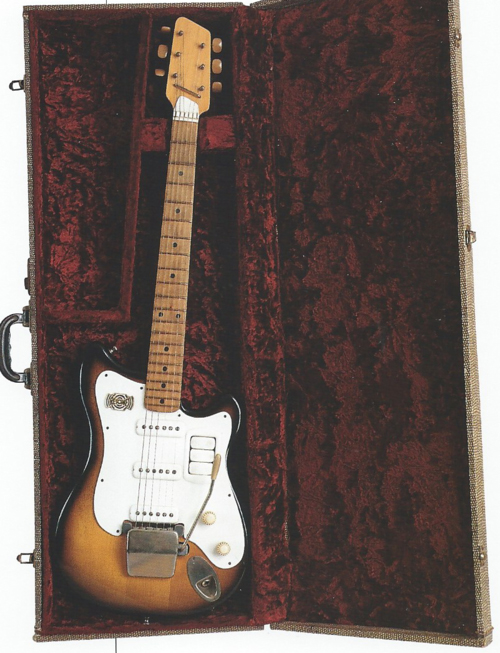

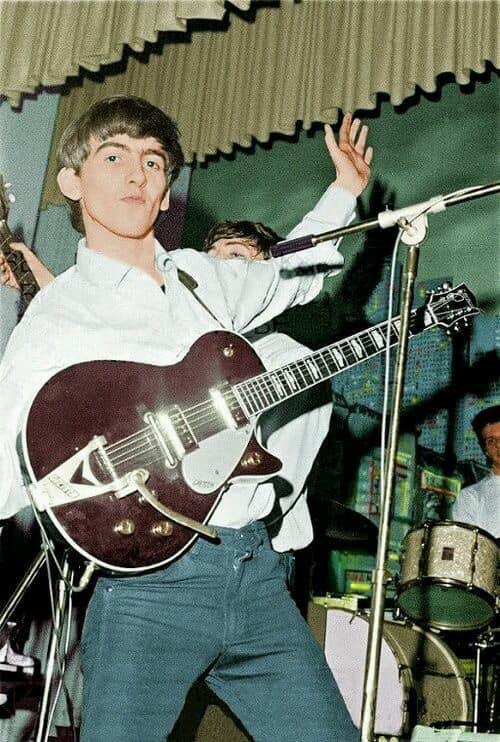

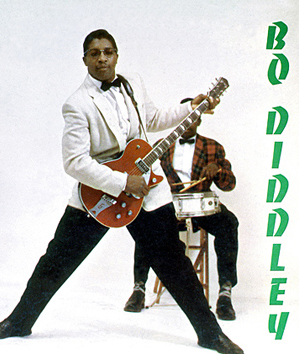
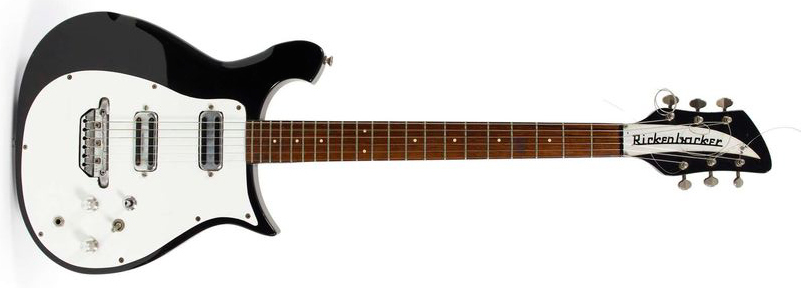














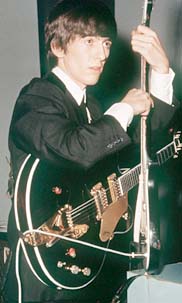






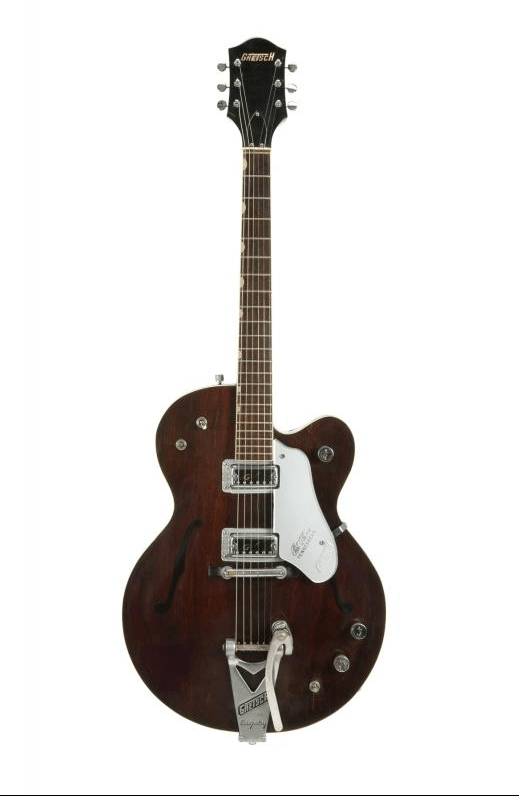


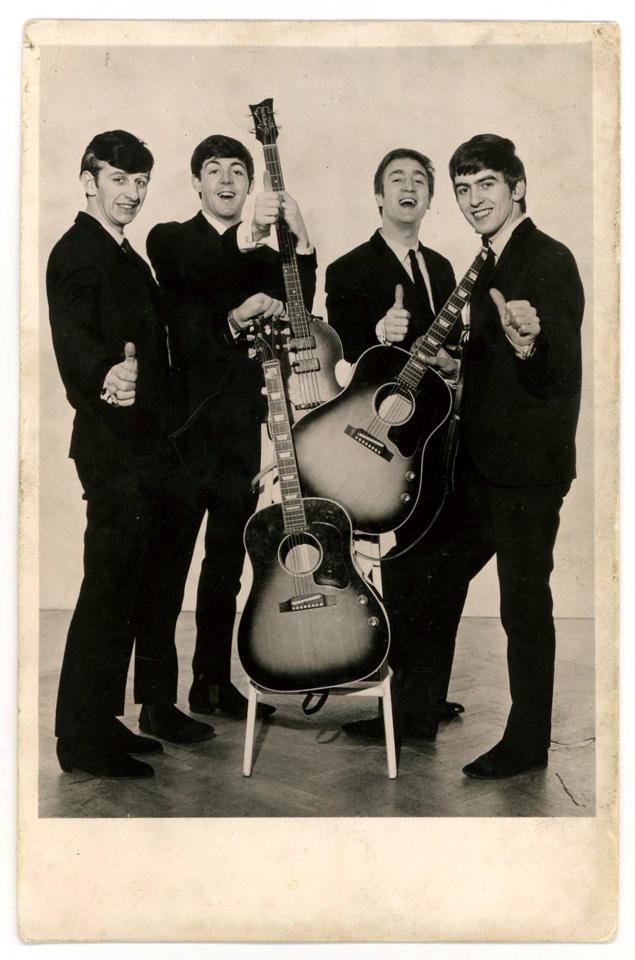







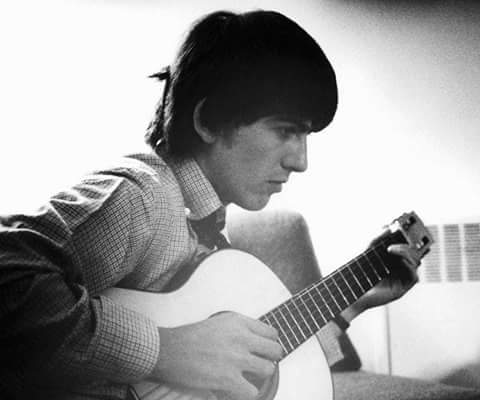









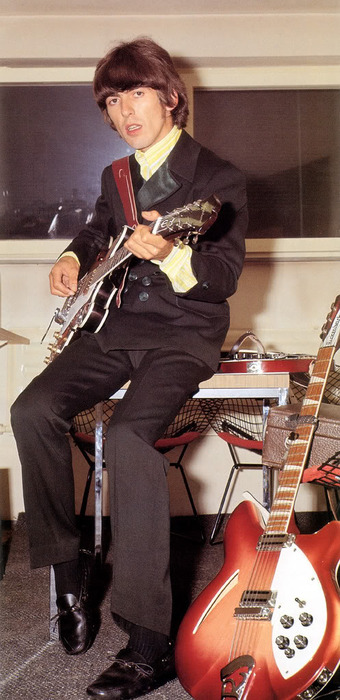
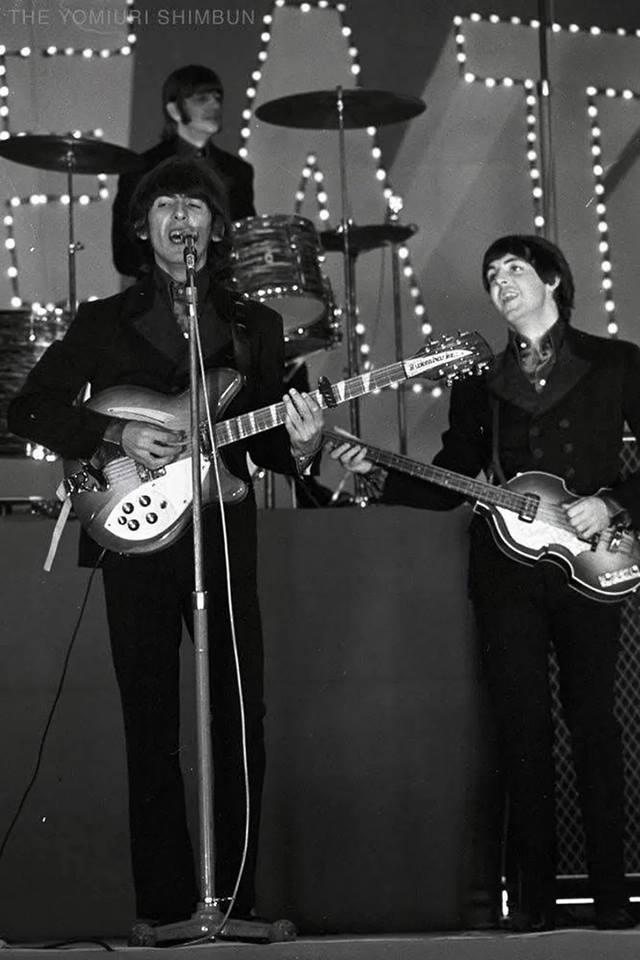
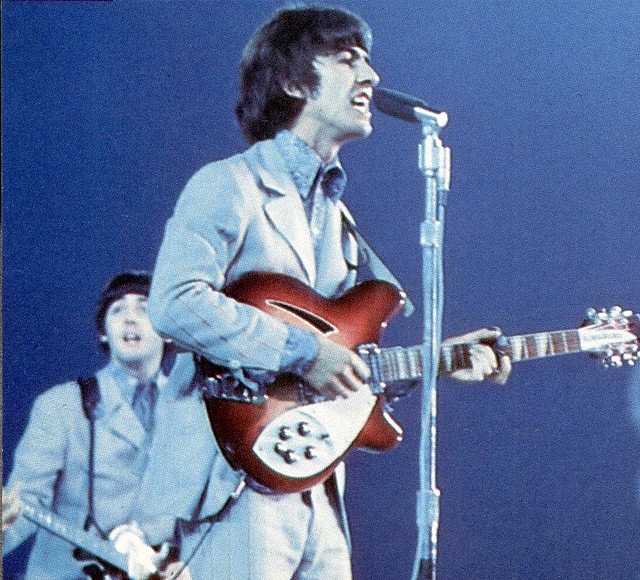





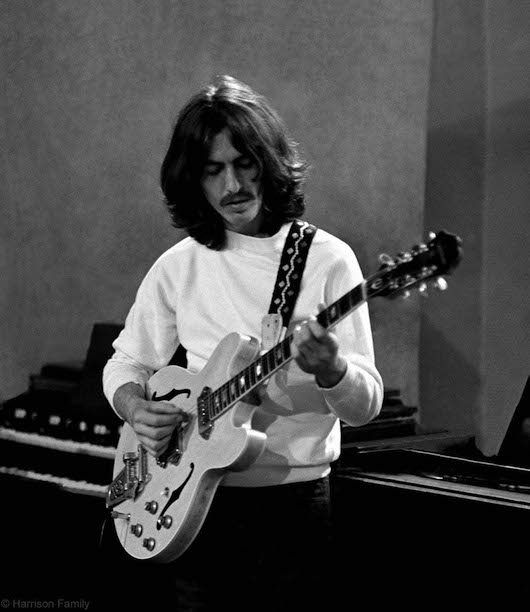


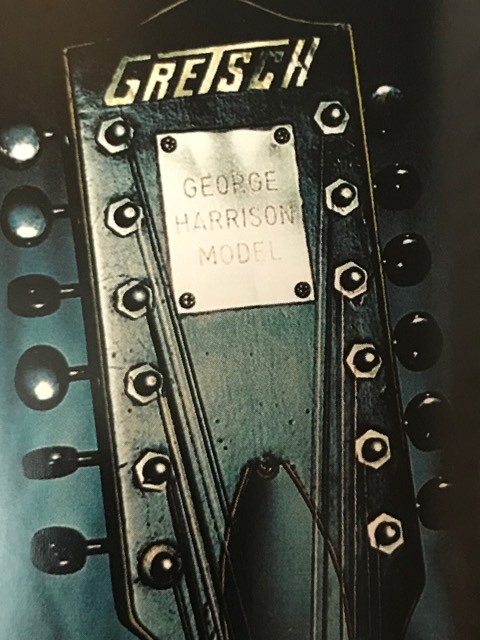

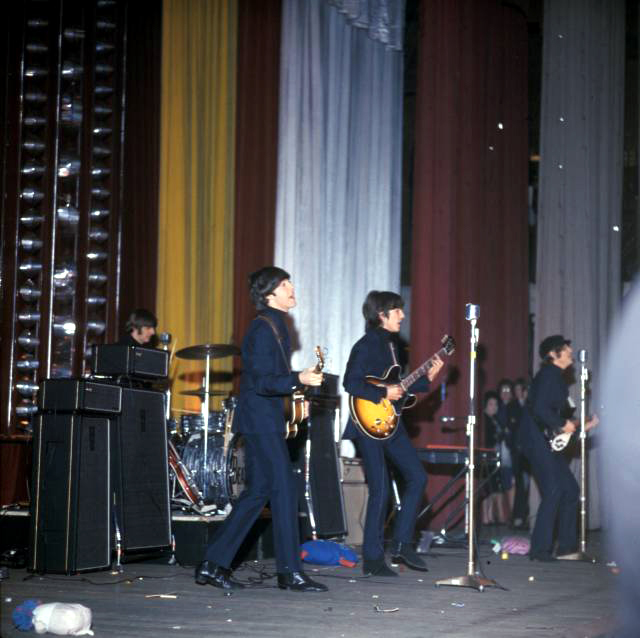




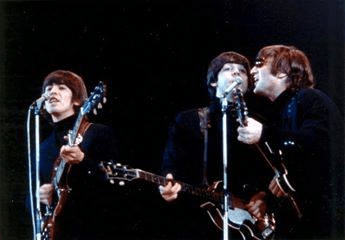

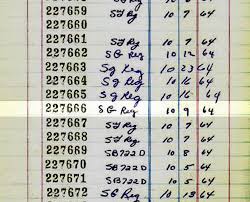













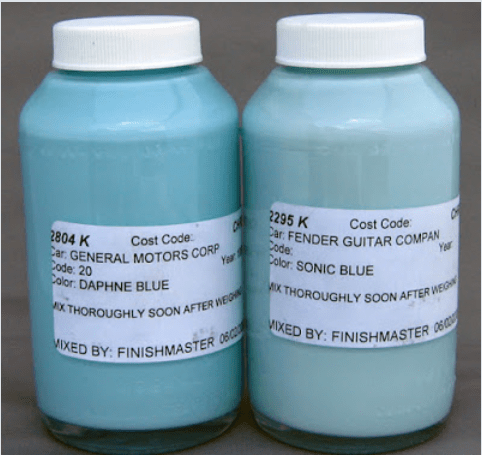

















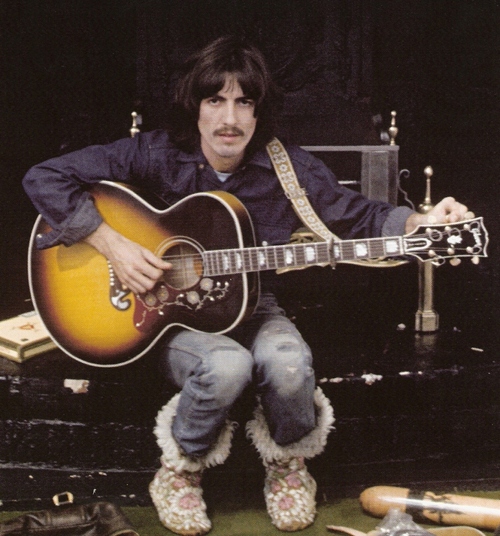






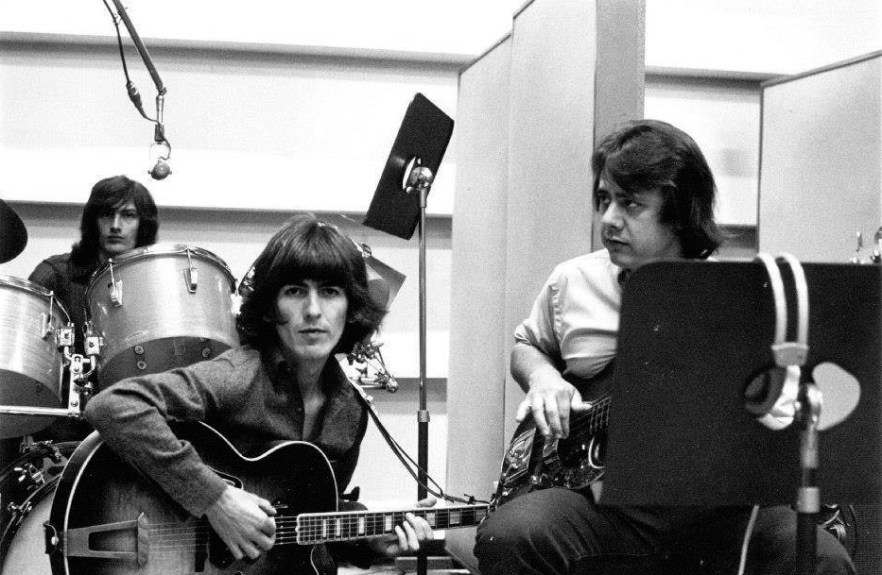




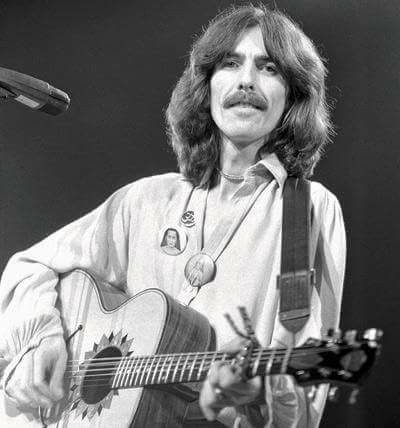





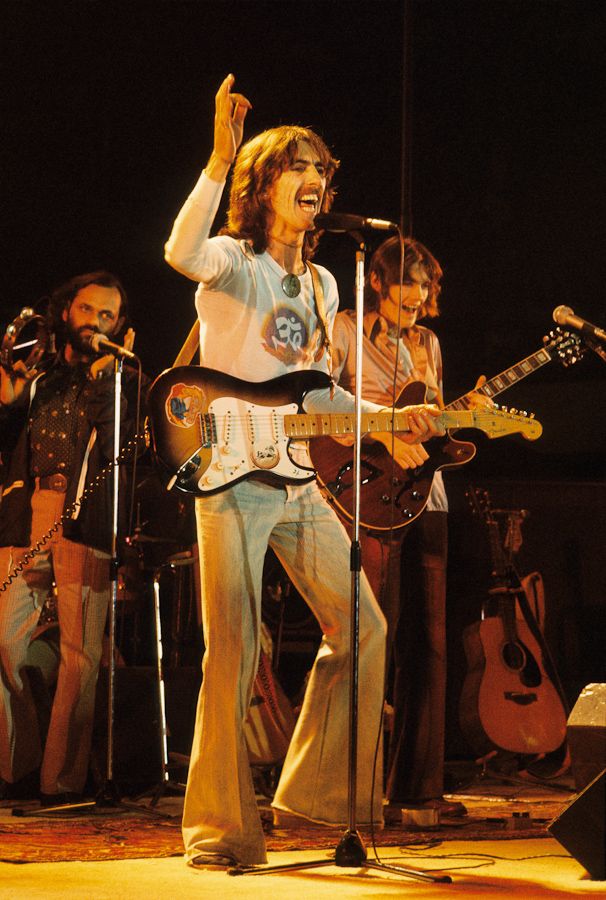
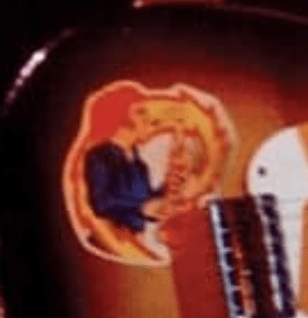




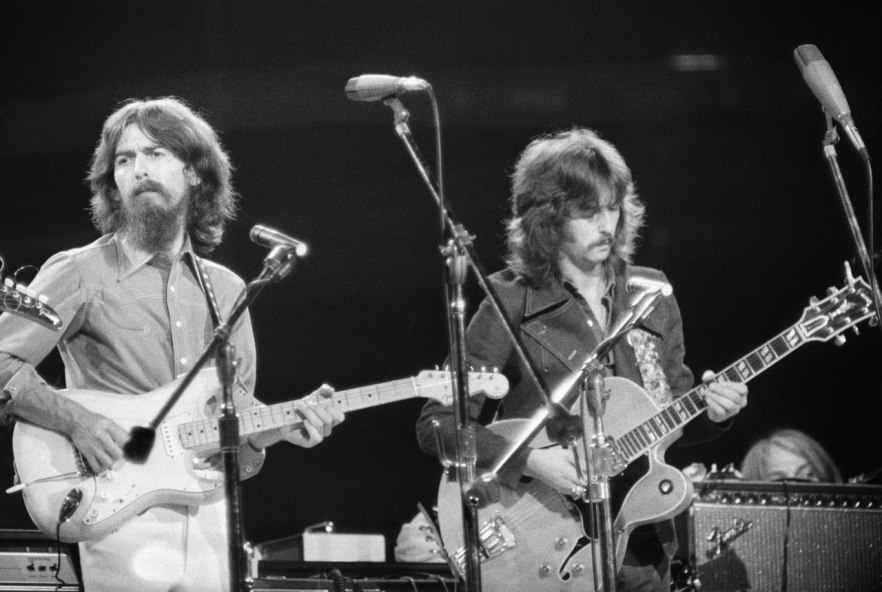






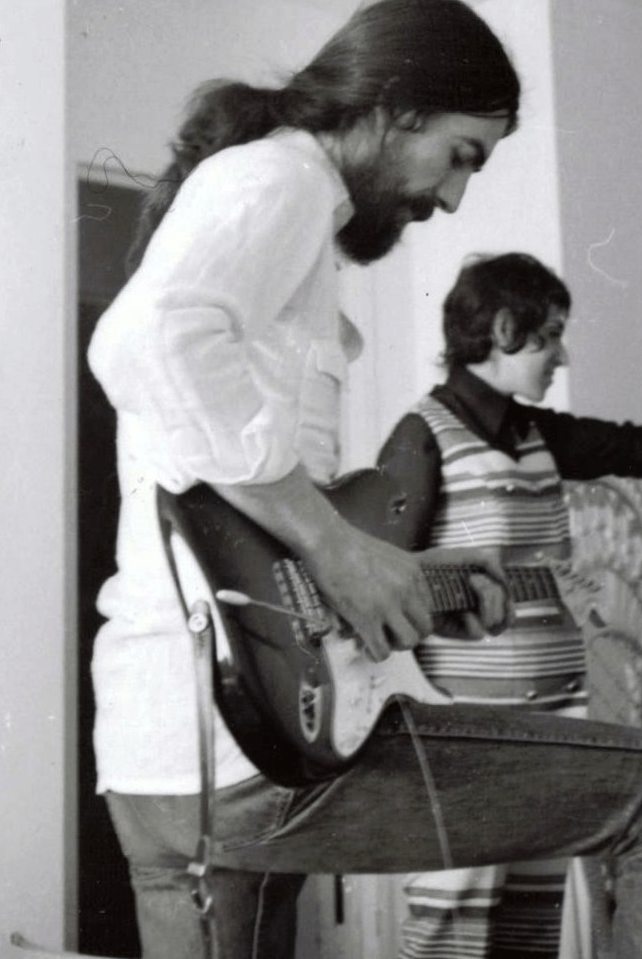




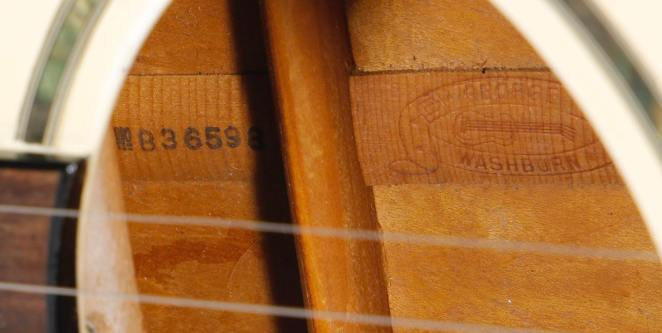
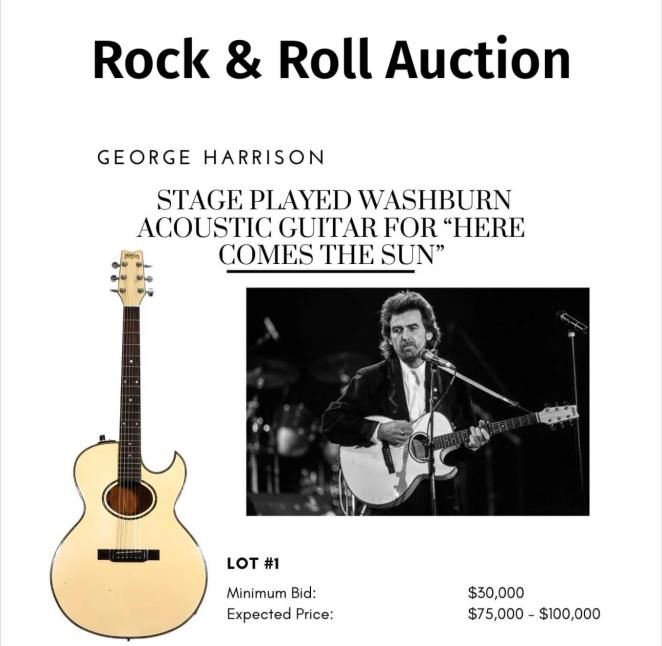
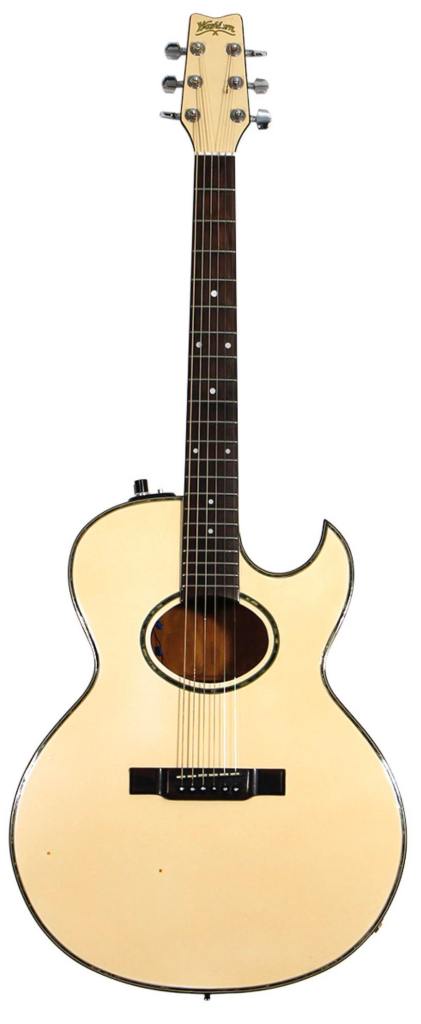


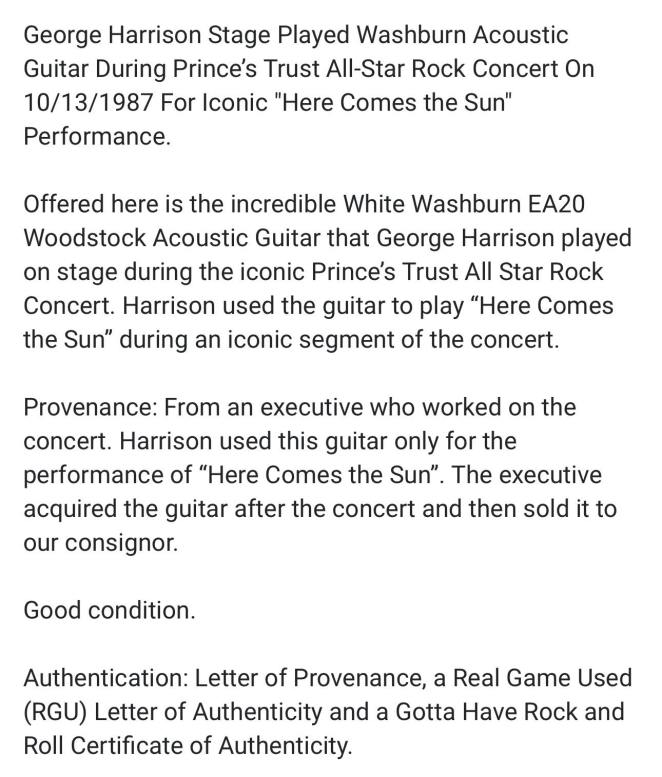











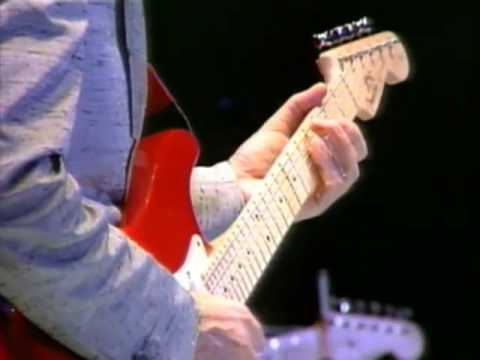
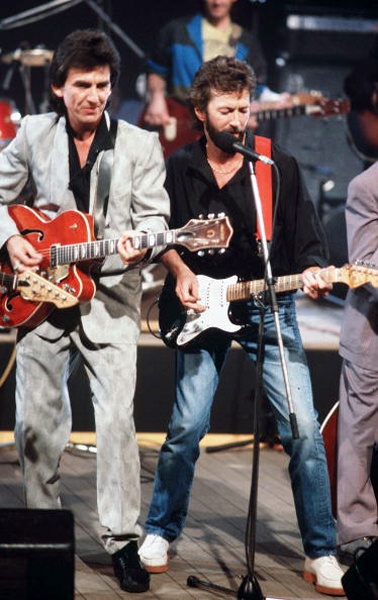
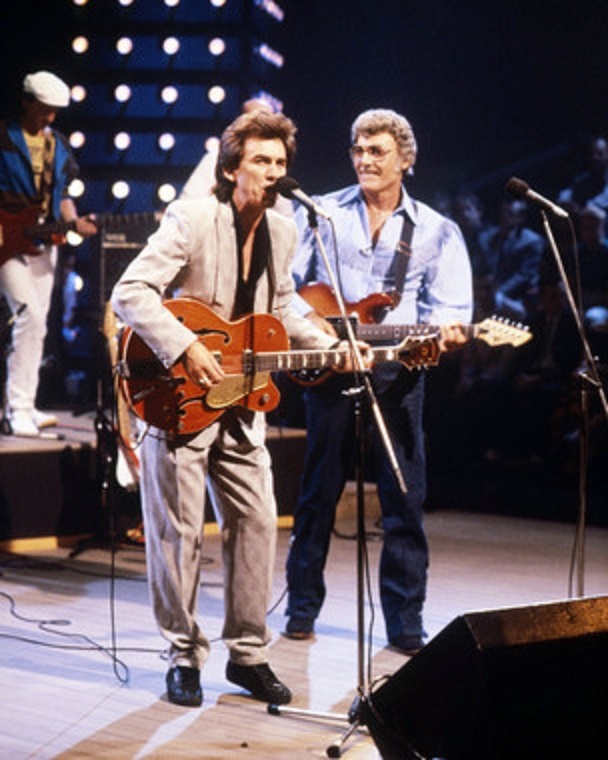




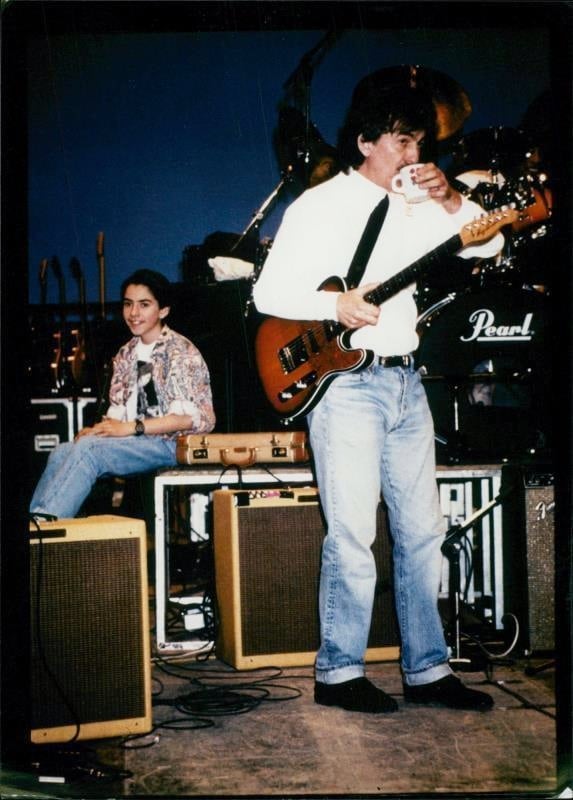

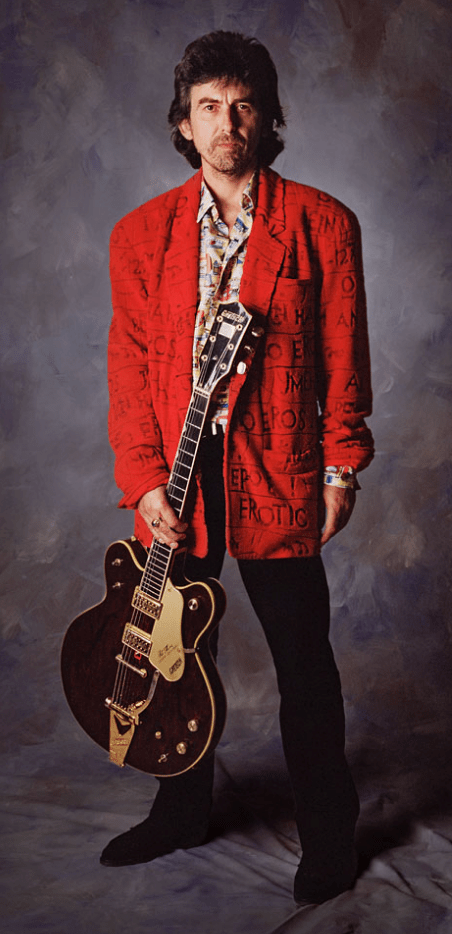

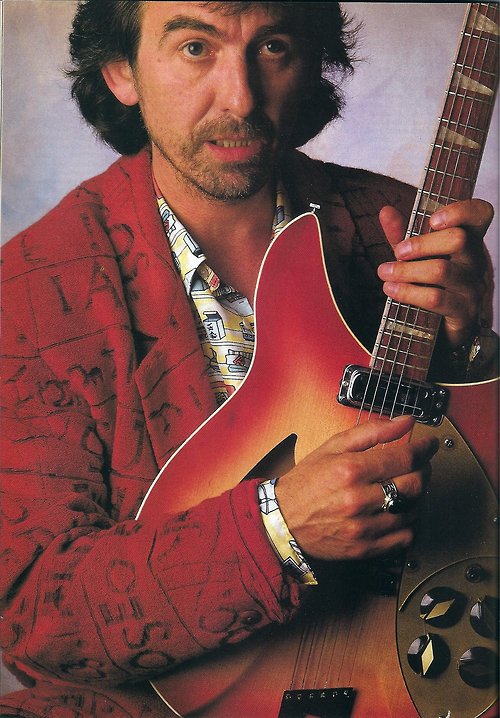









































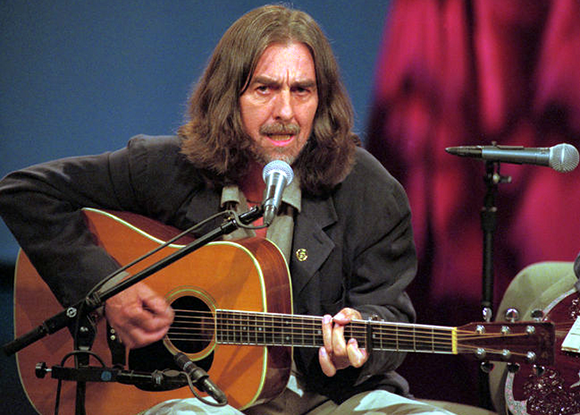
Great pictorial of Harrison guitars here. Particularly interesting is the “unknown guitar” 6 pics up … looks European to me. Could be wrong, but this is the first pic I’ve seen of George with it. Anyway, thanks for posting these.
Your welcome John. I’m glad you enjoyed the pictorial of George’s guitars.
Many updates on the George Harrison guitar pictorial page John. Drop by and have a look 🙂
Can’t find photo of dark sunburst Les Paul from “let it be album” saw one at prager-ritter on wasbash chicago,, in 68 or 69? Never saw another one!
I don’t think I’ve ever seen George with a dark sunburst Les Paul. Certainly no pictures of it that i can find. It’s not in the Beatles Gear either.
Does anyone know the serial numbers of the two 6122 Country Gents that George owned?
I cannot find any information on the serial numbers of George’s gents. Maybe Ringo will show the serial number of Georges second gent someday!
How could George use a guitar built in 1967 to record “And I Love Her” in 1964?
Oh, embarrassing! That made it by the proof reader! That guitar i believe was bought by George for Mary Hopkin. Thanks for pointing that out. I’ll have it fixed by the weekend 🙂
Yes, go right ahead, and thanks for asking 🙂
A mine of info and more than Beatles Gear for those of us who can’t get enough of the facts.Trying to put together a homage to some of Georges early guitars for the Merseyside Guitar Show November 2014….anything Beatlesque always draws a crowd to my stand.
Hi there! This article couldn’t be written any better!
Looking at this post reminds me of my previous roommate!
He always kept talking about this. I’ll forward this post to him.
Fairly certain he will have a good read. Thanks for sharing!
What’s pictured above as a “Blonde Gibson J-200” is actually a Gibson J-2000 cutaway.
http://www.guitar.com.au/guitars/acoustic/gibson/custom/j-2000.html
Thanks Stephen! I corrected that on the website. I appreciate that you stopped by to have a look at my pages 🙂
The guitar in the Jackie Lomax photos is actually a 3 pickup ES-5.
Thanks for identifying the Gibson ES-5 in the Jackie Lomax photos Joe 🙂 You rock!
You have a great shot of George (playing his Gretch Chet Atkins ) and Eric Clapton labeled as being in Japan. I’ve seen this concert many times. It’s actually a Carl Perkins concert. Here’s some information.
Rockabilly Session — Carl Perkins & Friends
TV SpecialAlternate Title: Carl Perkins & Friends, Cinemax Sessions (01/05/86) Check Youtube!
I’d also like to know what kind of guitar George has on his wall three pictures up from here.. I’m pretty sure it’s a lap, slide guitar.. It’s over his right shoulder at 10:00. Great site! Any plans on doing Pauls guitars?
Thanks for the feedback Buddyhoot! I do appreciate your help with corrections. I am working on Pauls guitar page and should have it up in a week or two.
Cara
VERY cool!
The logo on the ’69 Rosewood is often incorrect. In MANY instances you will see a more spaghetti logo in silver. And in some instances a truss rod plug. George’s logo is gold, and is not like the one’s often used. It also does not have a truss rod plug or skunk stripe. The Fender Custom Shop has made these guitars with the names “60’s Rosewood Telecaster NOS” NOS meaning New Old Stock. The Master built models however are more closely aligned with George’s guitar with the original gold logo and the COA reading ’69 Rosewood Telecaster NOS. The neck plates are often different as well. Some having the Custom Shop stamp, while others are original to Georges F logo stamp. The large picture in Andy Babiuk’s book is not in fact George’s original guitar. This has since been proved with the Dhani Harrison Apple App. of his fathers guitars.
This guitar must have been the least used guitar by George in the Beatles. He got it in January 1969 and gave it To Delany Bramlet 2 nd of December 1969.
George did not care much for this guitar as he was a Stratocaster player and it was Paul who ordered this guitar not George. George never once thought about it again in his life but 2 years after his death Olivia Harison buys it a an auction where Delany Bramlet sold it.
There are actually many photos of Georges Fender Rocky Stratocaster during the Let it be sessions and his Les Paul Lucy.
I know that Paul and John did take the meeting with the Fender rep Don Randall in 68″. The seed might have been planted at this meeting.
The statement from Fender HQ states that “Fender had decided to introduce solid-rosewood versions of its venerable Telecaster and Stratocaster, and Roger Rossmeisl was charged with producing custom prototypes, which the company planned to give to George Harrison (Telecaster) and Jimi Hendrix (Stratocaster) to provide publicity for the planned models.”
Thanks for the mention in the Rosewood Tele section. The sale of the guitar turned into a bit of a challenge for me. I had brokered a deal with Norm Harris of Norm’s Rare Guitars and at the last moment, Delaney decided to back out. I was upset at the time; not for any loss of a sale, but for the embarrassing chore of explaining to Mr. Harris the unfortunate circumstances. He too was initially miffed but we all got over it and Delaney is gone now. I tried getting the guitar back into George’s hands by writing his office but the lady I had dealings with (NOT Olivia by the way) was extremely rude and demanding. She could have arranged a sale through me and saved a lot of money. Be that as it may, the instrument ended up in the right hands, with George’s son, Dani.
Thank you for your post on my web page Mr Kyle. I was thrilled to hear from you and to hear the intimate details of the brokerage and sale of this iconic guitar. I would love to hear more about this guitar and your interaction with it, if you would allow that. I know you have written about it so please leave the book title here so we can purchase the book and learn more about it 🙂
Thanks again,
Cara Carlson
The Gretsch Tennessean in Ringo’s auction is not the one George used with the Beatles.
Really, Please tell me more. I would like to have the correct information on my page.
Awesome job! Do you know anything else about the Black Fender Strat George is playing? The picture is from his “All Things Must Pass” era….Bearded and long hair. Strat looks 60’s, no,truss rod on the top of neck…..
I don’t know anything about it other than the era it came from All things must pass. It does appear in the pictures of Georges guitar collection, hanging beside the dark horse strat.
In this song of George appears a guitar that it seems the rickenbacker 425 but i’m not sure if it’s the same of 1963. (min. 1:40) https://youtu.be/tB8ujgebtnw
I believe you are right GeorgeMartin93. It does look like the same guitar. Thanks for pointing that out 🙂
Watching the offical video of George Harrison’s song “This is Love” I noticed that appears a rickenbacker that it seems it’s a 425 model. Could it be that one George had in 1963?. I leave you the link of the video: https://youtu.be/g4hpKm2Lruo (The guitar appears in the solo)
Thanks for your work and effort. This is very nice stuff, and a a great expansion of the “Beatles Gear” books. Never forget the night show in Memphis (66). Seats behind the stage and Mal brought out the SG & Rick 12 and just laid em down on the stage behind the drums while Bobby Hebb was still doing his set. Of course George didn’t use the SG. But interesting as i don’t think it’s recognized he brought it on tour, only Casino.
Thank you Mike! I could listen to stories about the Beatles all day long. Please contribute any stories or memories you care to relate about the Beatles on this page any time you want to. I love the feedback and i love Beatles fans. I found a picture of the Beatles performing at the Memphis Mid South Coliseum in 66 and the SG was laying on the stage to the right of Ringo’s drums. http://www.gettyimages.co.uk/pictures/view-from-above-the-back-of-the-stage-as-the-beatles-news-photo-515817878
Under the photos for “1957 Gretsch PX 6128 Duo Jet. First American Guitar” it says……..”Stats: Rickenbacker PX6128 Duo Jet, a late 1957 model, featured a solid body, “cloud” inlays, a Bigsby® vibrato, black finish with a silver pick guard, and two DeArmond pickups.” Shouldn’t it have Rickenbacker replaced with Gretsch?
Thank you Peter, Yes of course you are right and i will fix that immediately! Beatles Fans Rock!!!
Hello, the picture of the Tennessean given to Ringo for the concert for george is not the same one used at Shea stadium or Help! for that matter for the simple and obvious reason the “F” holes on that guitar does not have any white binding around it . It must have been a second one he owned but never made public.
You’re right Klaus! Thank you for pointing that out. I will correct my comment on that page. I hope you enjoyed the site and thank you for stopping by 🙂
Very nice stuff! Lot of details! Very cool! Thanks from France!
Thank you Axel 🙂 I’m thrilled that you stopped by.
In the picture with Paul Simon, George is playing a Martin D-35S. The “S” designation is for “slotted headstock”, a feature on their 12-fret models. Thanks for this fun page!
Hi Chris, huge thank you for the info on on the MARTIN D-35S. I appreciate when Beatles/guitar fans stop by and give me updates on the guitars! YOU ROCK. Thanks again, Cara
Thanks for posting this!
You are most welcome 🙂 Thank you for stopping by – Cara
Have you seen the guitar that Maverick-Music.com has of George’s? I have the picks they show on their website. FYI
Ooooooo, that’s awesome. I’ll look into that more right away 🙂 Huge thanks Eric. 1982 Takamine F349 Acoustic.
Do you have copies that don’t have Maverick Music.com imbedded in them?
I do have on the picks but not the guitar.
Thats cool too. Alvin Lee was a fave of mine too! Got to see him at the El Macambo in Toronto. Small venue – 5 feet away from the stage.
Great write up, thanks! I recently bought a Sonic Blue stray… well, because John and George had them and used them on Revolver… you mentioned George’s was actually Daphne Blue…. I’ll have to go back to Andy’s book. Does this mean I have but another Strat ? 😀
Hell ya, you always need more guitars Phil! The Sonic blue vs Daphne blue has been a topic of conversation forever it seems. I find it’s impossible to be sure. I posted a colour comparison with both colours but they do fade and so i put this up for all to debate.
Cara
Great site!!! I have a question that I can’t find the answer to anywhere. Were either of the Gretsch Country Gentleman guitars that George owned black in color?
Hey Joe, George’s Country Gentleman guitars were not Black. According to Gretsch, they were walnut stain.
Thanks for the great article of George and his beloved guitars! Your scholarship is excellent (and so are the pictures). George never felt that he was a virtuoso. He once said, “I can’t put two notes together”, which was an exaggeration, to say the least. But he was comparing himself to the older guitarists that he admired, like Chet Atkins and the “gods” of his era, Hendrix, Clapton, Beck, etc. George’s gifts as a guitarist went beyond the ability to improvise an impressive solo. His sheer musicality is what helped to make the Beatles records so special.
My only issue with your article is the comment “history shows that George was every bit the songwriter and musician that John and Paul were”. We love George, but there was no songwriter like John, not even Paul. John’s best songs have a depth of feeling that are unequaled by any songwriter, before or since. They touched the heart, mind and soul. That’s why he was John Lennon.
Hi Angelo,
I know you’re right. George was a solo writer and could never reach John or Paul’s songwriting ability, but he did pen some iconic songs and we love him just the same. I read somewhere that John aspired to be the philosopher/artist, while Paul was the more disciplined/accomplished musician. Georges contributions were minimal, but still important. Saying that history showed that George was every bit the songwriter and musician that John and Paul were, was of course stretching it.
Great article. Us mere mortals can only dream about the perks of being a Beatle although dealing with theives must have been horrible.
I love your website, and the passion you put into it and into your respectful replies to people who have posted here. Many thanks for this.
I am writing about the sitar pictured here. This was George’s second sitar – i.e., NOT the one that he used on ‘Norwegian Wood’, which was a cheap sitar that he bought in London.
The sitar pictured on your page was bought by George in India.
I have quoted the story about the purchase and origin of this sitar below, from the Rikhi Ram webpage:
https://www.rikhiram.in/index.php?option=com_content&view=article&id=161:beatles-a-rikhi-ram-association-now-45-years-old&catid=20:frontpage&Itemid=1
One of the things that is not mentioned is that the sitar is a Ravi Shankar type sitar – i.e., the type used by sitarists of the Senia Beenkar Gharana (“Gharana” means “School”); these sitars have 7 main strings, and 13 sympathetic strings, and are different from the other main type of sitar, modified by Vilayat Khan (another great sitarist, like Ravi Shankar). The Vilayat Khan sitars (played by sitarists from the Etawah Imdadkhani Gharana have 6 main playing strings, and 11 sympathetic strings, and produce a lighther, ‘thinner’ sound.
“Beatles & Rikhi Ram association now 45 years
Rikhi Ram Musical Instruments and the great “Beatles” now completes 45 years of togetherness. Wow!
It was early July 1966, when they came to India and connected with my father late Pt. Bishan Dass Sharma at the Oberoi Hotel, New Delhi for Indian Musical Instruments like Sitar, Sarod & Tanpura. The picture on our website is taken in the Oberoi’s hotel room. George Harrison bought sitar, my father displayed those instruments by playing each of them.
What a historical moment it was for Indian Music! It was boom for Indian Classical Music in the western world. My father who had engineered George’s sitar, which lived as his favourite one in his life time. My salutations to all the great personalities.
Missing my father’s humble smile whenever talked about this moment. Prayers to pioneer of musical instrument making, Ever!…..my father Pt. Bishan Dass Sharma. Also to the great Beatles members, who are not around….. “George Harrison and John Lennon.
Sanjay Sharma”
There is footage of George having a sitar lesson with Ravi Shankar on youtube, which leads me to believe that he might not have played sitar on ‘Love You To’, which of course, is on ‘Revolver’.
I hope that this information is helpful.
Geert van der Veen
I love your website, and the passion you put into it and into your respectful replies to people who have posted here. Many thanks for this.
I am writing about the sitar pictured here. This was George’s second sitar – i.e., NOT the one that he used on ‘Norwegian Wood’, which was a cheap sitar that he bought in London.
The sitar pictured on your page was bought by George in India.
I have quoted the story about the purchase and origin of this sitar below, from the Rikhi Ram webpage:
https://www.rikhiram.in/index.php?option=com_content&view=article&id=161:beatles-a-rikhi-ram-association-now-45-years-old&catid=20:frontpage&Itemid=1
One of the things that is not mentioned is that the sitar is a Ravi Shankar type sitar – i.e., the type used by sitarists of the Senia Beenkar Gharana (“Gharana” means “School”); these sitars have 7 main strings, and 13 sympathetic strings, and are different from the other main type of sitar, modified by Vilayat Khan (another great sitarist, like Ravi Shankar). The Vilayat Khan sitars (played by sitarists from the Etawah Imdadkhani Gharana have 6 main playing strings, and 11 sympathetic strings, and produce a lighther, ‘thinner’ sound.
“Beatles & Rikhi Ram association now 45 years
Rikhi Ram Musical Instruments and the great “Beatles” now completes 45 years of togetherness. Wow!
It was early July 1966, when they came to India and connected with my father late Pt. Bishan Dass Sharma at the Oberoi Hotel, New Delhi for Indian Musical Instruments like Sitar, Sarod & Tanpura. The picture on our website is taken in the Oberoi’s hotel room. George Harrison bought sitar, my father displayed those instruments by playing each of them.
What a historical moment it was for Indian Music! It was boom for Indian Classical Music in the western world. My father who had engineered George’s sitar, which lived as his favourite one in his life time. My salutations to all the great personalities.
Missing my father’s humble smile whenever talked about this moment. Prayers to pioneer of musical instrument making, Ever!…..my father Pt. Bishan Dass Sharma. Also to the great Beatles members, who are not around….. “George Harrison and John Lennon.
Sanjay Sharma”
There is footage of George having a 1968 sitar lesson with Ravi Shankar on youtube, and his technique there leads me to believe that he might not have played sitar on ‘Love You To’, which of course, is on ‘Revolver’, from 1966. I say this because the sitar playing on ‘Love You To’, is more accomplished than that in the footage of George’s 1968 lesson. However, George may have really learned his part for ‘Love You To’, and might actually be playing the sitar on the track.
I hope that this information is helpful.
Geert van der Veen
I am so thankful that you brought this information to my attention Geert. I hope you will allow me to use this on this website. People seem to enjoy the web pages because fans like you fill in the missing pieces or correct information that is wrong. Your contribution is a welcome addition and I thank you very much! I see that Georges first sitar that he played on Norwegian Wood has gone to Auction and was sold in September 2017. I will expand this section and include your article. Thanks again, Cara 🙂
Hi Cara,Many thanks for your kind words, and yes, of course, please to use this on the website (that was why I wrote it). I thought that you would see that George’s first sitar had been auctioned fairly recently (September 2017, as you correctly said), so did not post about that. Here is a link to one of the pages about that sitar, including a photoBidding on George Harrison’s sitar starts at $50K
| | | | | |
|
| | | | Bidding on George Harrison’s sitar starts at $50K George Harrison’s sitar is looking to come together with a new owner. The late Beatles musician’s distinctive In… | |
|
|
May I ask what got you interested in posting about the instruments that George used? I also saw mention of a Paul page that you have done, so would you mind sending me the link? Please keep up the good work, Cara. Take care, Geert
From: tilonlysilenceremains To: gvdv@yahoo.com Sent: Sunday, November 5, 2017 10:33 AM Subject: [New comment] The Beatles and Beyond – George’s Guitars #yiv2897246206 a:hover {color:red;}#yiv2897246206 a {text-decoration:none;color:#0088cc;}#yiv2897246206 a.yiv2897246206primaryactionlink:link, #yiv2897246206 a.yiv2897246206primaryactionlink:visited {background-color:#2585B2;color:#fff;}#yiv2897246206 a.yiv2897246206primaryactionlink:hover, #yiv2897246206 a.yiv2897246206primaryactionlink:active {background-color:#11729E;color:#fff;}#yiv2897246206 WordPress.com speaknow132013 commented: “I am so thankful that you brought this information to my attention Geert. I hope you will allow me to use this on this website. People seem to enjoy the web pages because fans like you fill in the missing pieces or correct information that is wrong. Your ” | |
It is not just instruments that George played, it is John and (soon) Paul as well. My life changed in 1963 when i first heard the Beatles and then again in 1964 with the Ed Sullivan show appearance. After that i was hooked and i’m still hooked to this day. My love for the Beatles is complete. I learned very quickly that if the Beatles could do it, then so could i, (me and a billion other wanna be musicians). I taught myself to play guitar and drums and some keyboard and played in bands pretty much all of my adult life. I love guitars. The shape, the finish, the sound and the feel. I began to really appreciate the instrument and I’ve archived all of them on this web site – https://tilonlysilenceremains.com/. I created this site so i could consolidate all of the information floating around about the Beatle guitars to make it easier for fanatics like us to enjoy the history of them. Those instruments played the soundtrack of my life and i just wanted to recognize that. I do not have Pauls page complete. Finding time right now is difficult. https://tilonlysilenceremains.com/the-beatles-guitars-johns-guitars/
Have a great day Geert 🙂
Hi Cara,Many thanks for writing back. I really appreciated and enjoyed hearing your story, and what provided you with the motivation to do your George, John and Paul pages. I also envy you your conscious awareness of The Beatles, because I was born in 1962, and did not really become aware of them, or music, until about 1974 when (having been taken from Toronto to live in England after my parents’ divorce) it was all Glam rock – David Bowie, The Sweet, Slade, Gary Glitter – all stuff I hated (and still mostly hate). I could really sense wanting to get into music, and when I discovered The Fabs, I was hooked. But it was quite difficult to get information – not least because none of them were really talking about The Beatles at the time. Good that the films were all on TV at Christmas, and I did eventually find a book. And my efforts to play guitar (I think I have 12 of them right now!), and to write songs, have been completely inspired by The Fabs. I am not technically very good, but really enjoy playing, when my tendonitis allows. Take care, Geert
From: tilonlysilenceremains To: gvdv@yahoo.com Sent: Thursday, November 9, 2017 11:42 AM Subject: [New comment] The Beatles and Beyond – George’s Guitars #yiv3366994354 a:hover {color:red;}#yiv3366994354 a {text-decoration:none;color:#0088cc;}#yiv3366994354 a.yiv3366994354primaryactionlink:link, #yiv3366994354 a.yiv3366994354primaryactionlink:visited {background-color:#2585B2;color:#fff;}#yiv3366994354 a.yiv3366994354primaryactionlink:hover, #yiv3366994354 a.yiv3366994354primaryactionlink:active {background-color:#11729E;color:#fff;}#yiv3366994354 WordPress.com speaknow132013 commented: “It is not just instruments that George played, it is John and (soon) Paul as well. My life changed in 1963 when i first heard the Beatles and then again in 1964 with the Ed Sullivan show appearance. After that i was hooked and i’m still hooked to this day” | |
Oh you made me laugh Geert :-), I feel the same way about Glam Rock. My friends called them haircut bands. Just couldn’t get into the overwhelming and mind numbing use of synthesizers and synthetic drums beats and i turned away from that very quickly. I was born and raised in Toronto too. I know exactly what you mean about finding information about any band in the 60’s and 70’s. I remember trying to get lyrics off of new records by lifting the needle off the record and listening over and over and over to figure out what they were saying. (Long Cool Woman by The Hollies is a perfect example). Thankfully, the fabs put the lyrics on the back cover of Sargent Pepper! When the internet came along i was like a sponge. I needed to know as much as i could about the Beatles, mostly because they were the absolute one thing that affected every part of my life after that February night in 1964. I saved about a bajillion articles and pictures and then i found the fan websites really contained a lot of the same information as expected, but i wanted to go deeper, so i built this website. There is a lot of history in those guitars!
Hi Cara,I hope that you are well. Just posted in the George (and then tried to post in the John) section regarding the news today that John’s J-160E has been found, and is ‘alive’, well, and has been appreciated over the years since it went missing. I also just read your page about yourself, and I was drooling over some of those wonderful former/present guitars of yours. I have a mere twelve or so at the moment, but I love almost all of them. If ever you are in a jamming mood, I am at Bathurst and St. Clair, and can easily jump in a cab or on the TTC to get to most places. I am not all that great – still scratching around the blues scale after all these years – but I find it so hard to find people to play with these days. I gave up long ago booking rehearsal rooms because my friends would always pull out of the arrangement at the last minute. Anyway, all the best to you for the holiday season. Geert.
From: Geert To: tilonlysilenceremains Sent: Friday, November 10, 2017 6:05 PM Subject: Re: [New comment] The Beatles and Beyond – George’s Guitars Hi Cara,Many thanks for writing back. I really appreciated and enjoyed hearing your story, and what provided you with the motivation to do your George, John and Paul pages. I also envy you your conscious awareness of The Beatles, because I was born in 1962, and did not really become aware of them, or music, until about 1974 when (having been taken from Toronto to live in England after my parents’ divorce) it was all Glam rock – David Bowie, The Sweet, Slade, Gary Glitter – all stuff I hated (and still mostly hate). I could really sense wanting to get into music, and when I discovered The Fabs, I was hooked. But it was quite difficult to get information – not least because none of them were really talking about The Beatles at the time. Good that the films were all on TV at Christmas, and I did eventually find a book. And my efforts to play guitar (I think I have 12 of them right now!), and to write songs, have been completely inspired by The Fabs. I am not technically very good, but really enjoy playing, when my tendonitis allows. Take care, Geert
From: tilonlysilenceremains To: gvdv@yahoo.com Sent: Thursday, November 9, 2017 11:42 AM Subject: [New comment] The Beatles and Beyond – George’s Guitars #yiv3285726278 a:hover {color:red;}#yiv3285726278 a {text-decoration:none;color:#0088cc;}#yiv3285726278 a.yiv3285726278primaryactionlink:link, #yiv3285726278 a.yiv3285726278primaryactionlink:visited {background-color:#2585B2;color:#fff;}#yiv3285726278 a.yiv3285726278primaryactionlink:hover, #yiv3285726278 a.yiv3285726278primaryactionlink:active {background-color:#11729E;color:#fff;}#yiv3285726278 WordPress.com speaknow132013 commented: “It is not just instruments that George played, it is John and (soon) Paul as well. My life changed in 1963 when i first heard the Beatles and then again in 1964 with the Ed Sullivan show appearance. After that i was hooked and i’m still hooked to this day” | |
I’d love to jam someday but alas i live in Vancouver BC. A little far to go, but if i ever come back to visit my family, i will look you up! It would be great to meet a fellow guitar / Beatles fan. We could talk for days Geert, i’m sure 🙂 Have a good day and if i don’t hear from you before, have a fantastic Christmas holiday. (ask Santa for more guitars)
I think to little is written about Georges Fender Stratocaster ” Rocky” as it was used on 80 to 90 % of all songs with the Beatles after December1964 When he got it. George Harrisons absolute favourite guitar from 1956 untill he died was the Fender Stratocaster. He owned more than 300 Fender Stratocasters. He had the lion part of the official Fender Stratocaster book. In his solo career almost 100 % of his electric guitar work was Done with a Fender Stratocaster. George Harrison was probably the biggest fan of all guitarists of the Fender Stratocaster. He was going to buy a Fender Stratocaster 1957 but there was not one Fender Stratocaster in the whole Liverpool district because of a US embargo on certain products.
Breaking news – John’s ‘missing’ Gibson J-160E acoustic guitar found.
See here for more information.
http://www.prweb.com/releases/2015/07/prweb12876725.htm
It is good to know that John’s guitar has been looked after and appreciated all these years.
And that it has now been found!
That Harptone L /”12NC 12 string….I’ll bet it’s the same guitar Ringo is holding on the “It don’t come easy” 45 pic sleeve..?
Great picture. You never know huh. It could be the same guitar 🙂
I would like to know of any personal comments George made about his Tennessean. I purchased a 1965 model last summer. Thank you, Kerry
There are not a lot of comments from George that i can find, but i will do some more research and send anything i can come across. How do you like the guitar? Thanks for stopping by Kerry.
This is an excellent and fun as reading on information that guitar geeks, like myself, can enjoy as well as fill in gaps in our knowledge about such things. Thank you. One piece of information I am curious about is the year the sunburst strat with the Darkhorse sticker is?? Can’t find this info anywhere and was wondering if you had something on that. On the several pictures one can find, it almost looks to be a pre-59 as far as the sunburst goes…..almost looks two-tone and then other photos it looks more three-tone but it has no bullet truss-rod and a small-head with spaghetti logo….Just curious. Great work BTW!
Hard to tell if this is one of the Strats from Sho-Bud that Eric Clapton gave him in 1970. George said “I don’t have a whole lot of Strats. I’ve got a sunburst one, one that Eric gave me quite a few years ago. There was one that was stripped to the wood that I gave to Spike Milligan. I looked for a few years for information on the Dark Horse Strat, but no info has come forward.
Thank you for stopping by my website. I’m thrilled you enjoyed it – Cara
Definitely, the Blue Fender Stratocasters were ‘Sonic Blue’ …I own a vintage Fender Musicmaster which is ‘Daphne’ Blue – it is a richer, deeper blue with hues of turquoise, it is no where near the powdery Blue like the ‘Sonic Blue’ Stratocasters.
Hey Ralph, Thanks for stopping by. I agree with you on the colour being Sonic Blue. It’s amazing the amount of comments from fans believing the colour to be faded Daphne Blue. Will it ever end? ha ha 🙂
I bought a Squire Strat a few years ago specifically because it was Sonic Blue with a rosewood fingerboard…it’s a cool color, sometimes looks light green depending on the light in the room. Also have a Gretsch Pro Jet (like George’s Duo Jet and a Country Gentlemen…I once owned a Tennesean but sold it to my drummer when I needed cash…would love to have that back! Clearly influenced by George.
George’s Futurama is in Bonham’s auction on June 12, 2019 projected to go for $250,000 to $390,000.
So then, the Gretsch 6122 that he played on Ed Sullivan is ‘out there’ someplace? The back up was run over, but the Sullivan Gretsch is still under someone’s bed? Anyone know the serial number?
The Gretsch 6122 George played on Ed Sullivan was the back up. I think i do have the serial number and i’ll post it in a few days when i get home. Thanks Charlie X Charlie
Hi, well done, this site is very comprehensive and a great record of George’s iconic guitars.
I have the full background on the Bartell Fretless and am writing a book on this. It wasn’t given to Lennon as first indicated, it was In fact given to George during the first week of August 1967 by Al Casey. George took it back to a abbey Road and that’s when you hear John playing it on the Kenny Everett interview on the 6th June 1968. Lots more to this story if you would like to contact me. My twitter https://twitter.com/FindingFretless
I added your information on this guitar to the website. Please feel free to send any info on this guitar so i can update the website! Beatles fans are just simply cool!
Hi again,
I finally got to the bottom of the story of George Harrison’s Bartell Fretless, it has an incredible history. I wrote a book in the end called ‘Finding Fretless’ it is being published 12th August 2021 details at http://www.findingfretless.com
Hey! Fantastic site – I loved reading about all of the guitars George has used. I was wondering if you or anyone out there has any information on the Fender Jaguar (?) that George had played in the filmed version of Hey Jude? The body style seems to look like that of an off-set, but having three single coils like a Stratocaster really peaks my interest. I think it’s even pictured on this page under the category of the Nu Bass, in the photo where John is sitting down with his Natural finish Casino.
I ask because I would love to buy one myself but have a hard time finding the accurate name of the guitar. Thanks!
Hey Alexander. George was playing a Fender V1 6 string guitar in the Hey Jude video. The Bass VI was introduced in 1961 as a six-string bass (the 1961 Fender catalog referred to it simply as the “New six-string Bass Guitar”) and it occupies its own special ground somewhere between a guitar and a bass. The Bass VI has a bit of a split personality. It is perhaps best described as an elaborate cross between a Jazz Bass and a Jaguar guitar (which debuted in 1962, a year after the Bass VI), with a guitarist-friendly 30” scale (the standard length for short-scale bass guitars) and a Jazzmaster/Jaguar-like tremolo bridge/tailpiece assembly. It originally came in a three-color-sunburst finish on its 1961 introduction, with custom color finishes available in later years. Interestingly, the headstock logo said “Fender IV” in gold (not “Fender Bass VI,” as might be supposed), with “Electric Bass Guitar” in small black all-caps letters just below. Its original production run lasted 14 years, from 1961 to 1975.
Interesting tidbit about that VI model….legend has it that Glen Campbell used a Fender VI to play the solo on Wichita Lineman….that was Jaguar identity the guitar shared
Yes Glen Campbell did use the V1. Other notable mentions, John Paul Jones, Joe Perry, Duff McKagan, Robbie Robertson, Rick Danko, Jack Bruce, Ted Nugent, John Entwistle and of course John and George.
https://en.wikipedia.org/wiki/Fender_Bass_VI
Does anybody have any info on the Sonic Blue Strat with the maple neck that George plays on the ‘How Do You Sleep?’ sessions? Is it John’s ’62 with a neck change or is it just a studio guitar? Cheers Tony
Hey Tony,
There are a lot of stories floating around that it might be Georges sanded down Strat refinished to Sonic Blue, but it is probably just a studio guitar. That’s just my feeling and I have no data to back that up. Hopefully someone who was there at those sessions has some insight.
Thank you for the reply, yeah, George’s original Sonic Blue, pics of him using it before it became ‘Rocky’ are like hen’s teeth! Was wondering what happened to John’s and hoped it might be that one George lays the slide solo down but with a maple neck, the pondering continues….
The Squier Strat that George uses at the 1987 Prince’s Trust concert appears to be sunburst in the video (btw, the link wouldn’t allow me to view the video, I had to separately look it up) and not black. Is that correct or am confusing two different guitars?
Hi,
The Squier Strat that George is using on the 1987 Prince’s Trust Rock Gala concert is clearly shown in the video in the link below, and is definitely a tobacco burst (or whatever that black-to-beige/blonde colour is known as).
Have a look at 1.51 here
Yeah, in the article above, there is reference to a black Squire auctioned off and the the Japan LV Squier which George plays in the video. They are not the same guitar, I get that. The narrative was a little confusing, added to the fact that sandwiched in between is George with a black Fender Strat (Fender logo)
Lots of Fender Stratocasters are missing here. George had 4 Strats on the Dark Horse tour + his Fender Rocky Stratocaster. Here only one is shown. And it was said he owned between 50 and 100 Fender Stratocasters.
Hard to know how many Stratocasters George owned. From what I’ve seen online, he gave so many guitars away. George said in an interview that he didn’t have many Strats. Now that doesn’t mean he didn’t purchase or was gifted many more. It would be nice to see all of Georges guitars. Maybe Dhani will show us some day!
There was an app, now dormant, which featured a few of George’s guitars, but it was never updated to add more than the 5 or 6 it originally featured….Dhani was involved with its development.
Ya I had the app on my iPad. I really wish Dhani would have included guitars George played after The Beatles. I’m hoping for a miracle from Sean too. It would be cool to see John’s guitar collection. I get the decision to feature the Beatles years guitars but it would be nice to see the collections huh!
Also there were 3 Stratocasters used at the time of the Bangladesh. One Sonic Blue ( Not Lennons) one white used while backing an american artist on american tv and the wooden Stratocaster used on the Bangladesh concert.
I think you labelled a Rickenbacker 360 6 string as a 330 [2 pictures of George in red jacket about 2/3 of the way down the page]. The guitar has the shark tooth inlays making it a 360. The 330’s have always had dot inlays on the fretboard as far as I know. I think the shark tooth inlays is the only real difference between a Rick being labelled as either a 360 or a 330.
Thanks for the heads up John. You’re absolutely right! The guitar was labelled as a 330 Jet-glo in the article. I missed that but thanks to your keen eye we have now corrected the error. #BeatleFansRock
Cara 🙂
I have an acoustic guitar Epiphone Caballero FT30, serial # 122202, got it from a friend that bought it I London back in the 1970’s or 80’s with papers that said that used to belong to George Harrison. Unfortunately my friend lost the papers. I’m trying to verify this. Any help in this matter would be gratefully appreciated.
There’s one picture here with a similar guitar, or could be the same guitar, is the picture where George and Steve Nicks are together in Hawaii.
Wow, I hope you can locate those papers! This Epiphone guitar was made in 1961-1970
6 digit serial numbers cannot be decoded to an exact year. Unfortunately it’s impossible to identify the guitar in the photographs of George and Stevie, but clearly it’s very similar. I’ll check through some pictures of George’s collection and at the Epiphone archive pages to see if I can find a guitar like that.
I have this acoustic Epiphone Caballero FT30, serial number 122202, 1963 model. I sent a note about this yesterday but I couldn’t sent pictures. I friend bought it in London back in the 1970’s or 80′, with papers that said that used to belong to George Harrison. I’ve being trying to verify this. I found this picture of George with a very similar guitar, looks like the same guitar. Any help in this matter would be gratefully appreciated. Here is a picture of the guitar and a picture of George with what appears to be the same guitar.
El vie., 27 de may. de 2022 1:34 p.m., tilonlysilenceremains < comment-reply@wordpress.com> escribió:
Thank you.
El vie., 27 de may. de 2022 1:34 p.m., tilonlysilenceremains < comment-reply@wordpress.com> escribió:
If you look close at the binding, and some details it looks the same.
El sáb., 28 de may. de 2022 8:23 a.m., Rodolfo Jimenez rodostrat@gmail.com escribió:
The 1963 Maton MS-500 Mastersound is in the collection of Indianapolis Colts owner Jim Irsay. I saw it on display with the collection at Lucas Oil Stadium in Indianapolis on September 9, 2022.
Hey Stephen, I just saw that online a few days ago. I did not realize that Mr Irsay had purchased that guitar. If that collection ever makes it to Canada, I will be first in line! Thanks for the update 😊
Steve Bonne of Lovin’ Spoonful told me that John Sebastian never owned a Goldtop Les Paul. Steve’s brother Skip had a Goldtop and it may be the one that ended up being refinished by Derringer.
Hey Bob, I read that story about John getting the 57 gold top from Skip as well. I also read that there was a black Les Paul involved and another from a person who claims he was the first owner who sold the gold top for $175.00 to another player who sold it to John. (Maybe that was Skip, I don’t know) So many stories, so much confusion. I don’t know if we will ever know for sure. Beatles Gear barely mentions the fact that John Sebastian was a previous owner.
I have to correct myself, sorry. The Sunburst belonged to Skip, but never John. The Goldtop that became Lucy belonged to Steve. There is a photo online of their early band.
Minor discrepancies: 1) George & John’s Casinos were 65’s. Paul’s was a ’62. 2) Lucy never belonged to John Sebastian. It belonged to Skip Boone, brother of Spoonful bassist Steve. 3) There were numerous takes of While My Guitar… Take 20 something is on YouTube. 4) The Bangla Desh Strat was the blue one that George played on Lennon’s album ‘Imagine’ It was soon sanded natural. The sunburst Strat that EC gave him was played by Eric himself at the evening show.
What happened to the J-200?